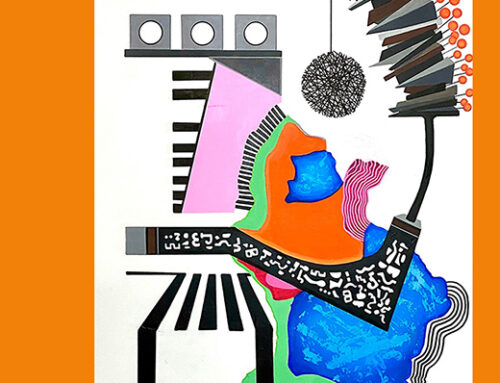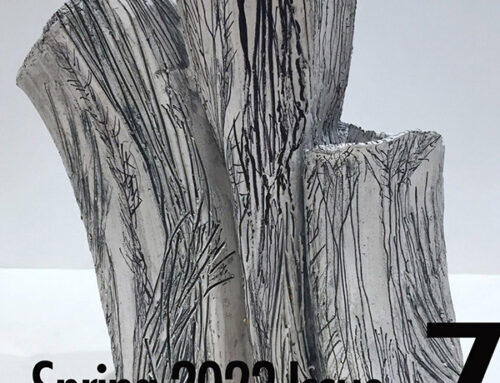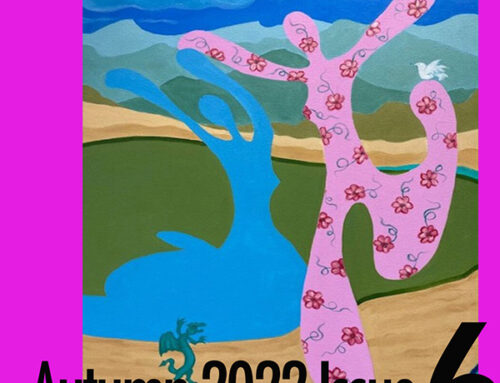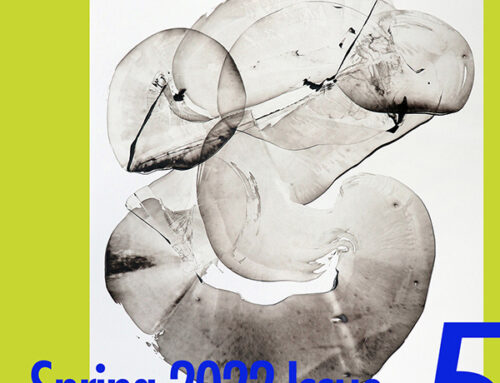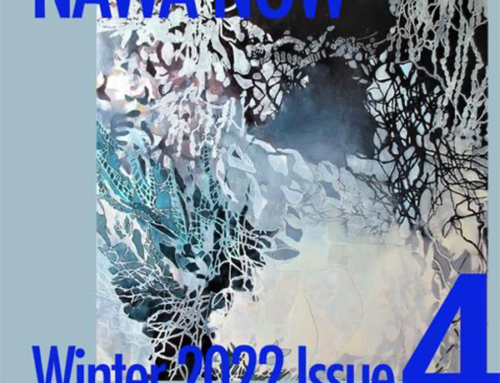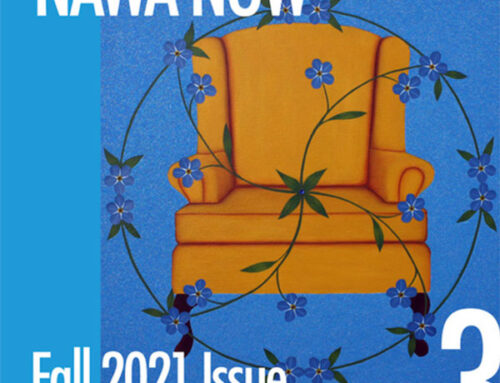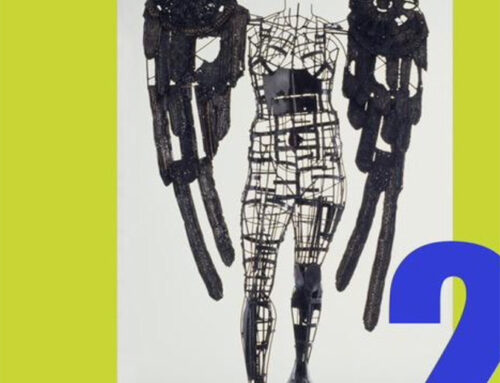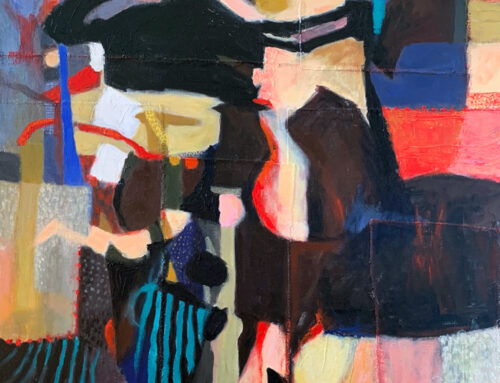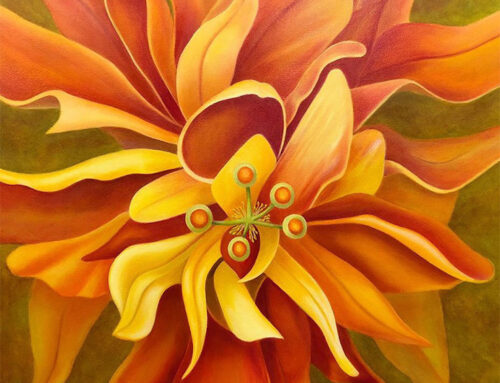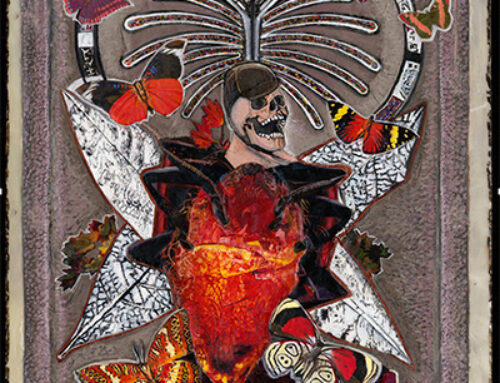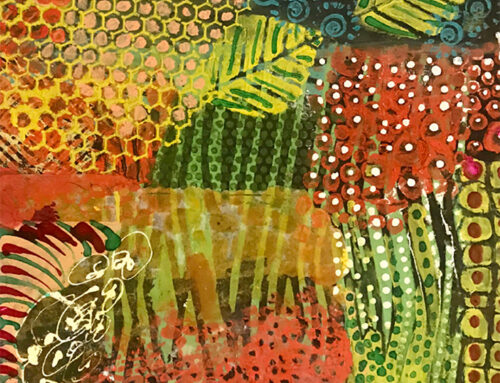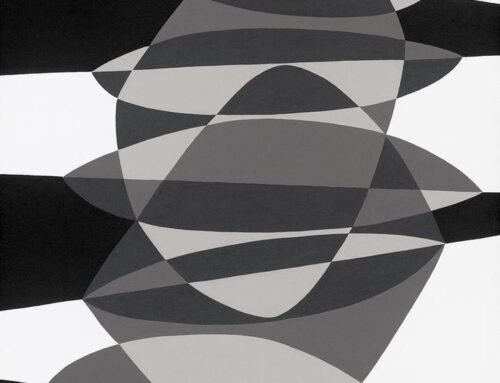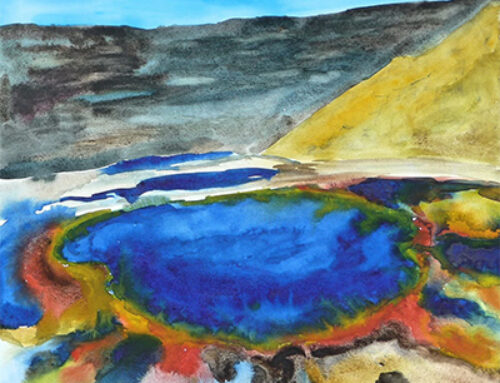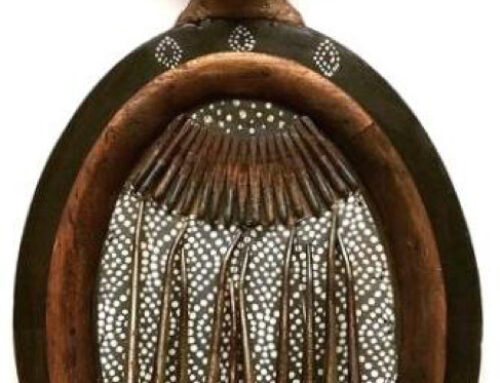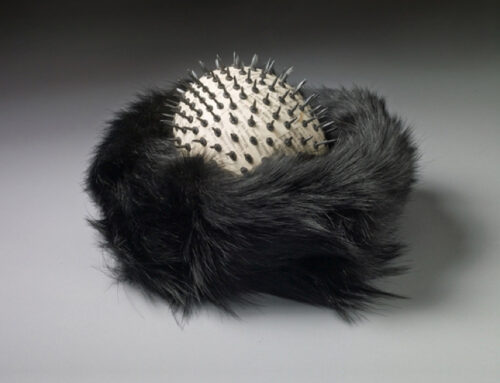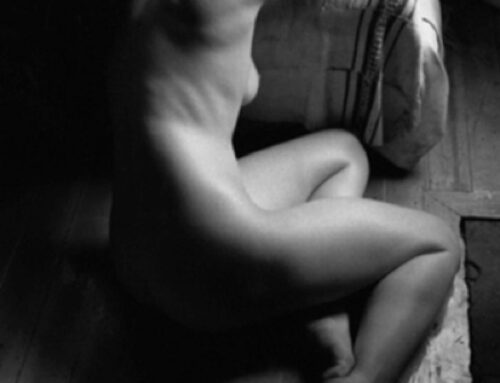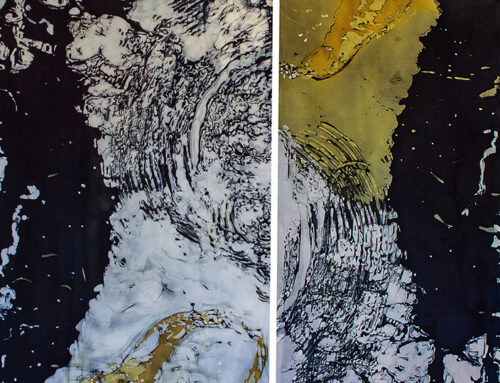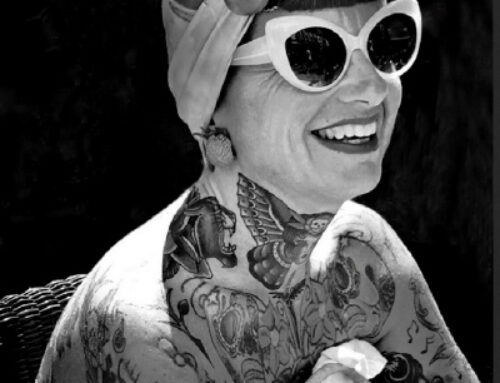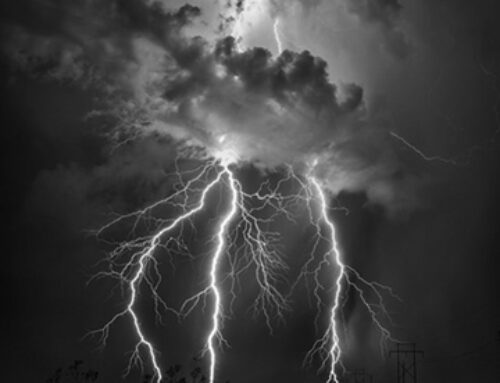
March 2021
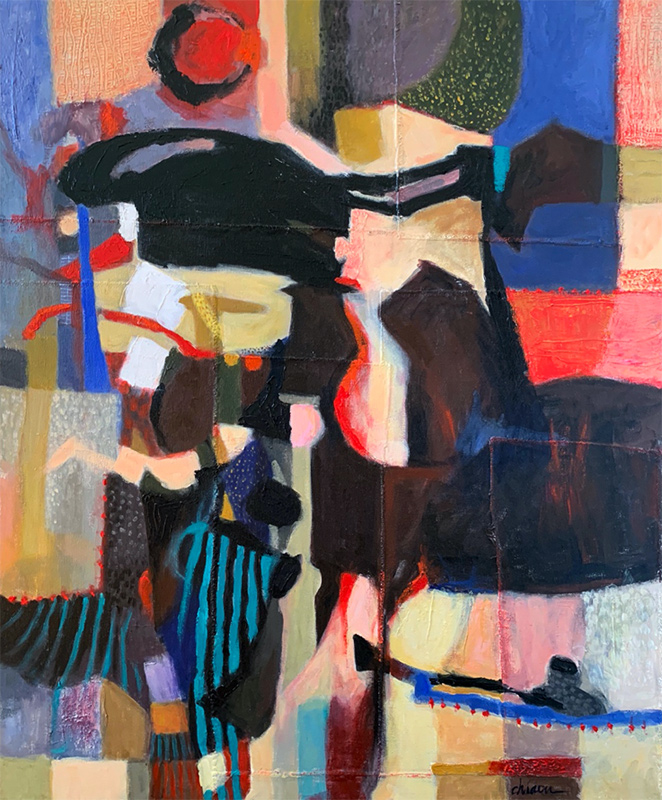
Patricia Chiaco Apuzzo, Centaur Whimsy, Acrylic & oil stick on pieced canvas, 28 x 34 in.
ABOUT Centaur Whimsey
I have always been inspired and awed by the primitive shapes and figures in cave paintings and in ancient African and Aztec art. Centaur Whimsy is part of a series of paintings in which I explore those elements. Pieces of canvas are stitched together to give it a textile feel and to add another dimension. Vivid color and different mediums also play with the primitive-like forms. Although these elements were the inspiration for my painting, it is what each viewer sees and feels that is the ultimate description for Centaur Whimsy.
PRESIDENT’S CORNER
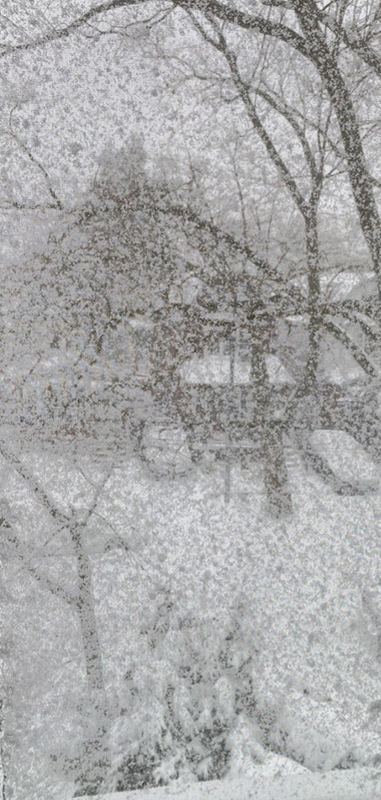 This year is revealing a lot of unexpected and unusual experiences.
This year is revealing a lot of unexpected and unusual experiences.
(We have included for your enjoyment a personal letter from President Natalia Koren Kropf detailing from her own point of view the challenges and sense of accomplishment that NAWA’s move to the National Arts Club has entailed, following her quarterly update below. Please also note the pictures and description of NAC’s historic premises in this issue. SB)
The New year is bringing us new hopes and new possibilities with the new office.
As the snowy blizzard has swept across the East Coast, our team is focusing on NAWA’s online exhibitions and virtual events, making sure NAWA is even more visible online. Although the quarantine is still in place, the social climate is hopeful for a change, and we all crave more in-person exhibitions and events. However, we are hoping for the Fall Season to be our coming out of the shell, and for the next six months, we will be online only.
With our new series NOON with NAWA, we are happy to see our members over the zoom every last Wednesday of the month at noon, to share the updates and answer any questions you might have. Please check your emails often for all NAWA announcements and zoom links.
Meanwhile, we have interesting online exhibits on our home page.
Cold, Resilience of Grief, Small Works Winter, the latter is the NAWA version of Affordable Art Fair, hence the size limitation. We are honoring March Women’s History Month with the exhibition Special Women. HERstory.
Our PR committee is working hard to keep the members together through the very engaging Facebook Members Group. If you have not done so already, please join us to keep our vibrant art community alive and interactive, share your work in progress, share your news, and most importantly, look at other artists’ work and give them your feedback.
Also please subscribe to NAWA YouTube Channel with amazing content and inspirational interviews.
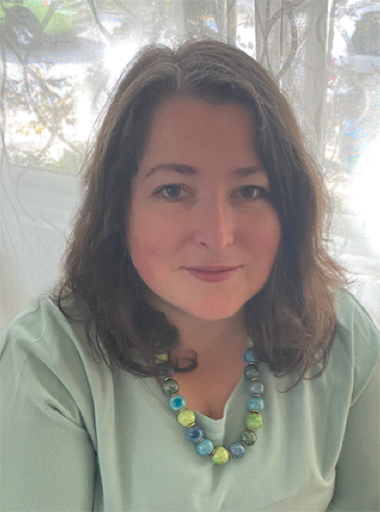
NAWA’s NEW HEADQUARTERS
By
Natalia Koren Kropf
Thanks to a combination of circumstances, good luck, and extensive communication with all parties involved, NAWA has officially moved into a landmark building formerly known as Samuel Tilden Mansion, which bears a National Historic Landmark dedication plaque on the exterior wall. Some of you are familiar with the NAC which has hosted NAWA Annual Luncheons in recent years—a tradition we will be able to keep at a discounted price from now on!
While some of you may google “National Art Club NYC” to find out more about its history, I would like to tell you a story that will become NAWA’s history.
As our lease was ending, NAWA Board members were looking for an answer “To stay or to go?”
On one hand, we had an office with a gallery, in a location familiar to the members—next to public transportation, Port Authority, and Penn Station. On the other hand, during the lockdown due to the COVID-19 pandemic, we had been closed with no certain date to reopen. As of today, in February 2021, we are still operating remotely. We could not use the gallery nor allow visitors immediately after reopening.
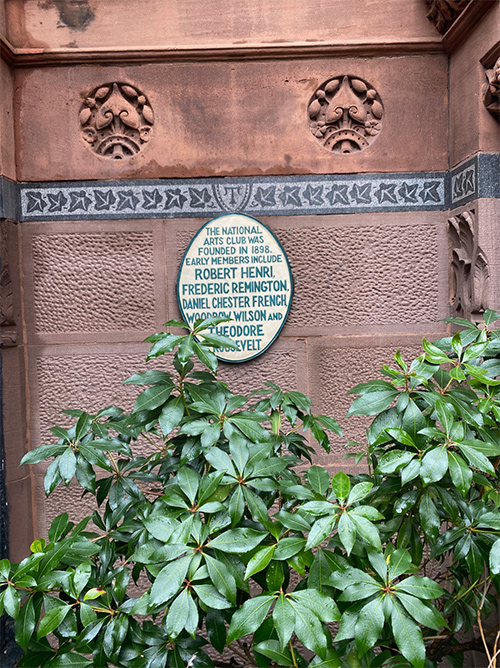
Life in NYC as we know it has changed. We had moved our exhibitions and operations online, we developed our social media outreach, but the question remained unanswered: Shall we wait through the pandemic lockdown or take a risk, to make a move, and save money?
Luckily, one of NAWA’s members, Judi Gilden, who is also a member at The National Arts Club, was in communication with Susan G. Hammond in the past regarding NAWA Luncheons and other events hosted by NAC. I am thankful to Susan G. Hammond, former Executive Director and current Board Advisory member, who recommended Judi Gilden. Ms. Gilden remembered that NAWA formerly had shown interest in the NAC spaces. However, the timing was off, and the mutual interest did not come to fruition at that time.
Susan reached out to Judi to see if any spaces might become available during the six months of the Quarantine. Some of the guest rooms were being converted into offices and at a much lower cost than a regular office space.
By then we were successfully operating the office remotely. We had four online exhibitions, the 131st Annual, as well as hosting Virtual Receptions, establishing Online Jurying, distribution of the Awards, accepting New Members, and showcasing their work online. Theoretically, we could do with a limited size office and no gallery attached.
Several Board members (each time in different combinations) had been coming to the National Arts Club to see room availability. They were shown several rooms and we had to navigate between the size, the cost, and the location within the building. I had to negotiate a lot. The correspondence was quite extensive!
Ultimately the Board had to make the final decision: To keep paying high Manhattan rent with an uncertain prospect of re-opening in a year OR to move into the prestigious National Arts Club in a landmark building with a well-known historical address? Everyone on the Board exclaimed: “It’s a no-brainer!”, voting unanimously.
Now with Judi’s recommendation and Susan’s past business connections to NAC, the inquiry was sent out, revised, and to our amazement the spaces were available. Thus, the space for NAWA has been secured and that space is magnificent!
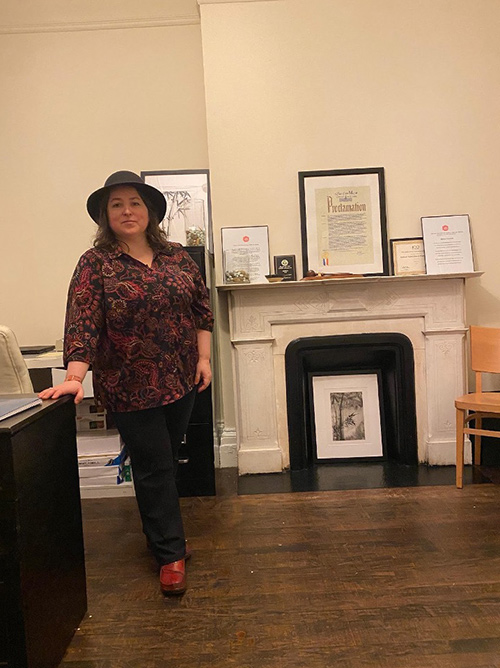
Personally, I am grateful to everyone who has made the transition to the office possible. First of all, my dear husband Eric H. Kropf who came with me to NAC on several occasions to help move the office furniture to the third floor without the elevator (!) and who offered his advice during the correspondence with the NAC Housing Committee. I would also like to thank Biana Kovic and Jill Baratta, who besides organizational work and correspondence, were physically involved in the move, packing and unpacking, and setting up the new office. It is a good thing we are in shape!
Professionally, I would like to thank each and everyone on the NAWA Board of Directors for their support, advice, and trust that everything would turn out well in the end.
You may be wondering about the loss of the physical gallery. We shall see. At this time, it is too early to tell, but one thing we had noticed while wondering in the maze of the NAC hallways, was their remodeling of gallery spaces, merging them into one ground floor gallery with movable walls.
Now the construction is complete, and we are in the process of negotiating the scheduling and pricing as the proud new tenants of the National Arts Club.
A WORD FROM BIANA
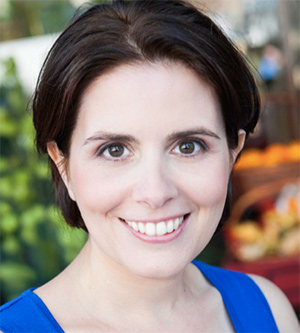 Dear NAWA Community,
Dear NAWA Community,
I hope that you are continuing to engage in creative expressions during these unprecedented times.
The past three months have been very exciting and busy for NAWA.
On December 30th, we have proudly moved to our new location, 15 Gramercy Park South, Room 301, New York, NY 10003. NAWA also has a new phone number, 646.461.0068. We hope that this location will help us significantly impact the art world and look forward to hosting exhibits in 2022.
As most of you know, we have successfully moved all our scheduled exhibits online. Please visit the website (www.thenawa.org) to view your peers’ outstanding work if you have not done so already.
I am overjoyed to say that we have welcomed 38 new members from 17 states in January. Furthermore, we will have a new members exhibit and reception in April/May, and I invite you to mark your calendars. NAWA will be accepting new members’ applications again from March 1st to March 30th through www.showsubmit.com. If you know of any fellow artists who would enjoy being part of our community, please invite them to apply.
One of our goals for this year is to add additional features to the NAWA member accounts. You can currently add your website or a social media platform that features your work by simply logging into your member account, which will automatically update our member directory.
NAWA ‘s goal is to keep open communication with our members. This year we are taking a step further and are proud to say that NAWA’s President, Natalia Koren Kropf has started to host a live Zoom event called NOON with NAWA. The event will be hosted every last Wednesday of the month.
Lastly, our social media platforms are growing. If you have not done so already, please visit our YouTube channel, follow us on Instagram, like us on Facebook or join our Facebook GROUP which is exclusive for members.
As always, I wish you continued success and creative expression.
Warm Regards,
Biana
NAWA IN THE NEWS
NAWA HEADQUARTERS MOVES TO HISTORIC ARTS BUILDING
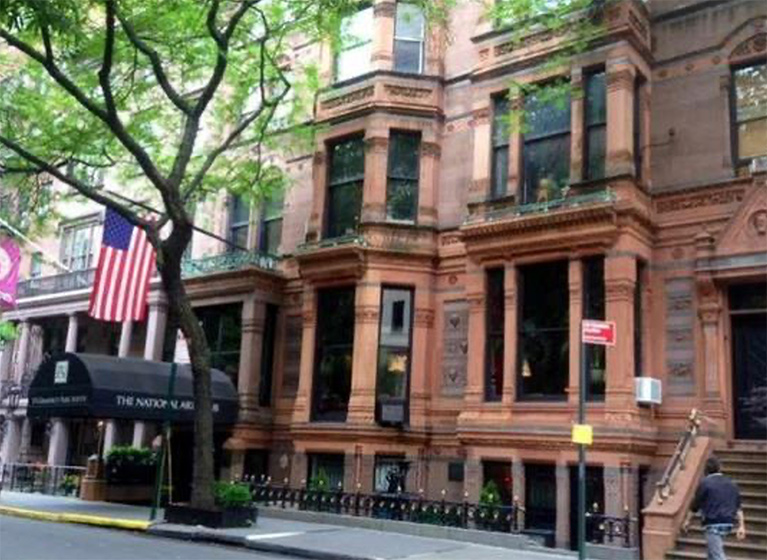
The National Arts Club in the Historic Tilden Mansion
NAWA headquarters is now located in the prominent National Arts Club landmark building at 15 Gramercy Park South, Room 301, New York, NY 10003. Our new office space is located on the third floor of this iconic building overlooking Gramercy Park.
The initial connection began with the involvement of Judi Gilden, active member of NAWA and NAC; the support and recommendation from former Executive Director Susan G. Hammond; the negotiating efforts of President Natalia Koren Kropf and her husband Eric H. Kropf, Vice-President Jill Cliffer Baratta, Executive Director Biana Kovic and the legal advice of Mark Altschul. This was finalized by the approval of the entire NAWA Board of Directors who voted unanimously on the move and were supporting advisors throughout the process. NAWA is extending its gratitude to all those who have facilitated the office transition during the hazardous times of global lockdown due to the COVID-19 pandemic.
Founded in 1898 by Charles DeKay, a literary and art critic for the New York Times, the National Arts Club was first located on West 34th Street. The club quickly outgrew its original location, causing a search to begin for a larger, more suitable space.

Interior images of the staircase and parlors
The former home of Samuel Tilden, twenty-fifth governor of the state of New York at 14/15 Gramercy Park would provide such a space, becoming the National Arts Club’s permanent location. Governor Tilden had redesigned the mansion to combine two buildings, 14 and 15 Gramercy Park which were both built in the 1840s. The redesign included stained glass panels by John LaFarge and an exquisite stained-glass dome created by glass master Donald MacDonald in what was originally the library. Sculptures, elaborate bookcases, door framings, and solid wood banisters completed the look of his stately home.
In 1906, the mansion was acquired by the club with the help of Spenser Trask. The building was declared a New York City Landmark in 1966 and designated a National Landmark in 1976.
Today, the National Arts Club houses its own art collection and has four gallery spaces which host exhibitions year-round. Numerous programs, private events, art classes and presentations are held at the club each year. It also has a restaurant and bar open to members and guests. The building has been utilized for prominent films and television productions.
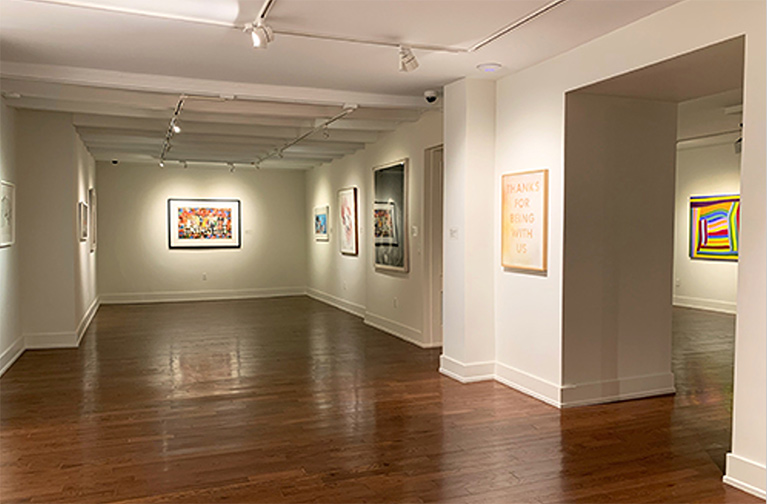
Recently expanded Gallery Space
It is fitting that our historic organization, the National Association of Women Artists, established in 1889, has found a wonderful home joining forces with the historic National Arts Club.
NAWA EXHIBITION AWARD WINNERS
COLD Awards
1st place: Winter, Christine Whalen-Waller, acrylic with collage
2nd place: The Throw Away Society, Joanna Biondolillo, photograph
3rd place: Snowy Day, Nancy Jacey, colored pencil on Illustration Board
Honorable Mention: Skating on the Frog Pond, Boston, Carolyn Latanision, watercolor
Winter Small Works Awards
1st place: The Lady of Shalott, Victoria Maria Ermler, oil on canvas
2nd place: Toe Shoes, Mary N. Hurwitz, sculpture
3rd place: Stepping Out, Sharon Krinsky, mixed media collage
Honorable Mention: Quagga, Edie A. Dillon, mixed media sculpture with found objects
Honorable Mention: Lena, Chesleigh Meade, mixed media collage
Honorable Mention: Lone Tree in the Lavender Field, Cynthia Fleury, color photography
Resilience of Grief Awards
1st place: Benjamin 1944, Sonia Stark, photography
2nd place: Gunned Down Grandsons, Patricia Anderson Turner, sculpture
3rd place: Memories and Monoliths, Linh Vivace, oil on canvas
Honorable Mention: Looking into the Depths, Pamela Flynn, seed beads on canvas
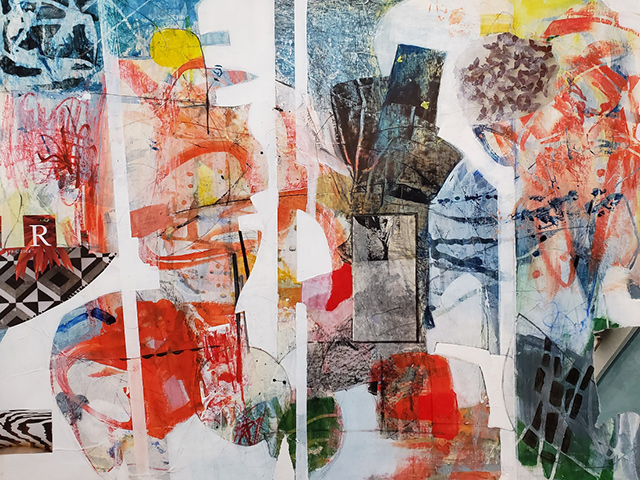
COLD first place winner: Christine Wallen-Waller, Winter
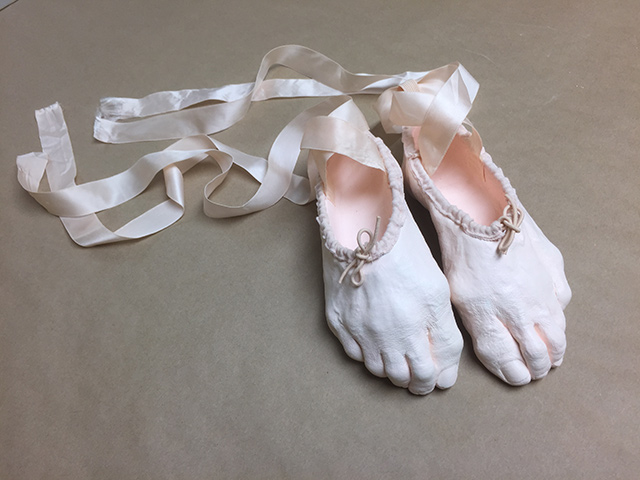
WINTER SMALL WORKS second place winner: Mary N. Hurwitz, Toe Shoes
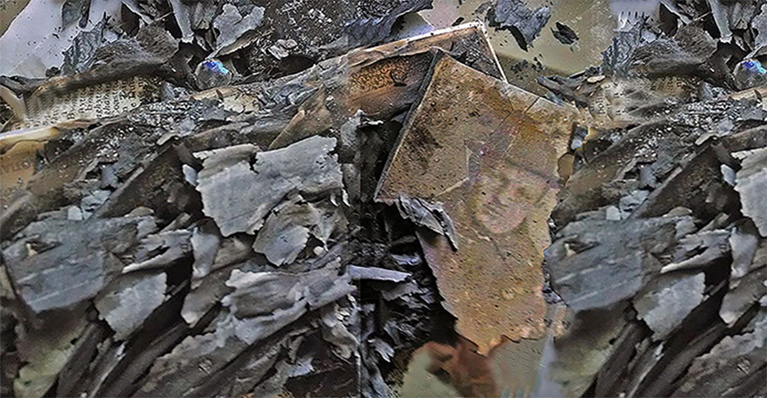
RESILIENCE OF GRIEF first place winner: Sonia Stark, Benjamin 1944
RED CARPET NAWA MEMBER
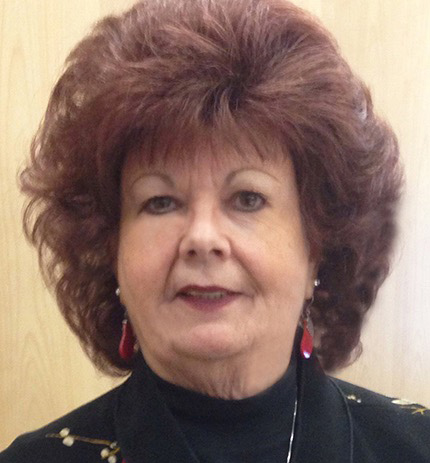
(When I decided to feature Susan so that readers could appreciate her art, her life, and her important and big-hearted connection to NAWA, I knew it would be interesting for our readers to get to know her better. Her long-time relationship with NAWA as a president and an executive director was impressive enough but when I discovered how much she had actually accomplished, I was overwhelmed. Should I include it all? Of course! How could I eliminate any of the passion and persistence she embodies? Absolutely not. So here it is. She really does keep ten balls in the air at once! SB)
When did you realize that the camera could be a way of expressing yourself?
In 1990 while working for the Department of Defense as an illustrator, I was sent to the Aberdeen Proving Grounds Army Base in Maryland, to do a photo shoot of the front panel of an Army tank that eventually was used in Desert Storm. I used a secured government camera to take these images. I enjoyed this experience so much that I purchased a small Canon 35mm camera and decided to start taking photographs of objects, scenery, and the usual images that a beginning photographer would take. That’s how my hobby got started and then grew into a professional contemporary fine art photography career.
Did your parents encourage your creative interests?
My father was a civil engineer, and I would watch him work on blueprints and sketches of his assignments. My mom took art classes at a local high school and was a John Nagy paint-by-numbers fan. I always saw both parents working on their creative projects. My grandmother on my father’s side was a business woman, but took numerous art classes with masters of Chinese calligraphy and pen and ink drawings. I have a few of her works hanging in my home.
Who were your muses? Was it a particular person, teacher, friend or another source that inspired you?
I was very fortunate to study with several muses who inspired my photography and also my love of the arts: Mary Ellen Mark, Joyce Tenneson, and Ernestine Rubin.
Mary Ellen Mark encouraged me to capture documentary images and images pertaining to the darker side of life. She talked about her photojournalism and diverse cultural images, both at the Woodstock School of Photography and her studio on Greene Street. My thesis was on Encroachment, how roadkill was a symbol of the clash between nature and civilization.
While visiting Joyce Tenneson’s studio and viewing images of her impressive portraits, I was especially attracted to her images and a book called Wise Women. Her use of studio lighting to capture the body, facial expressions and moods were stunning. It helped me understand the importance of capturing the special traits of each person using lighting and expressions.
Ernestine Rubin was the first professional woman photographer that I had the privilege to work with. She inspired me to use my imagination and to look beyond an image. Her strength was in capturing and combining sensuousness and the body. I was then able to combine the male and female body with the landscape to create a mood and/or a metaphor.

Diamonds, black and white photograph, 20 in. x 16 in.
Each of these powerful women photographers inspired me on my path of capturing unique images. I would also like to add the names of my grandmother Elsie G. Hammond and my Mother Virginia Hammond, who always encouraged me to do what I enjoyed doing.
Do you believe that your education in the field was of paramount importance, or was it your own intuitive investigation that enabled your development?
I was encouraged by two TV personalities, Miss Francis of the Ding Dong School and Winky Dink (hope some people remember them), when I was about 3 or 4 years old. I could go up to the TV screen and copy what I saw. I have always been interested in doing artwork. I would doodle in my notebooks, work extra hard on art projects, design flyers and even work on set designs for class plays and events.
When I started work for the Department of Defense in New Jersey, I was a clerk but worked my way up to the Art Department by taking numerous courses and finally achieved an AA from a community college, and a BFA and MFA from William Paterson University.
Creativity and love of art was always a part of my spirit, and curiosity about the different mediums, combined with education and years of practice, definitely enabled my development.
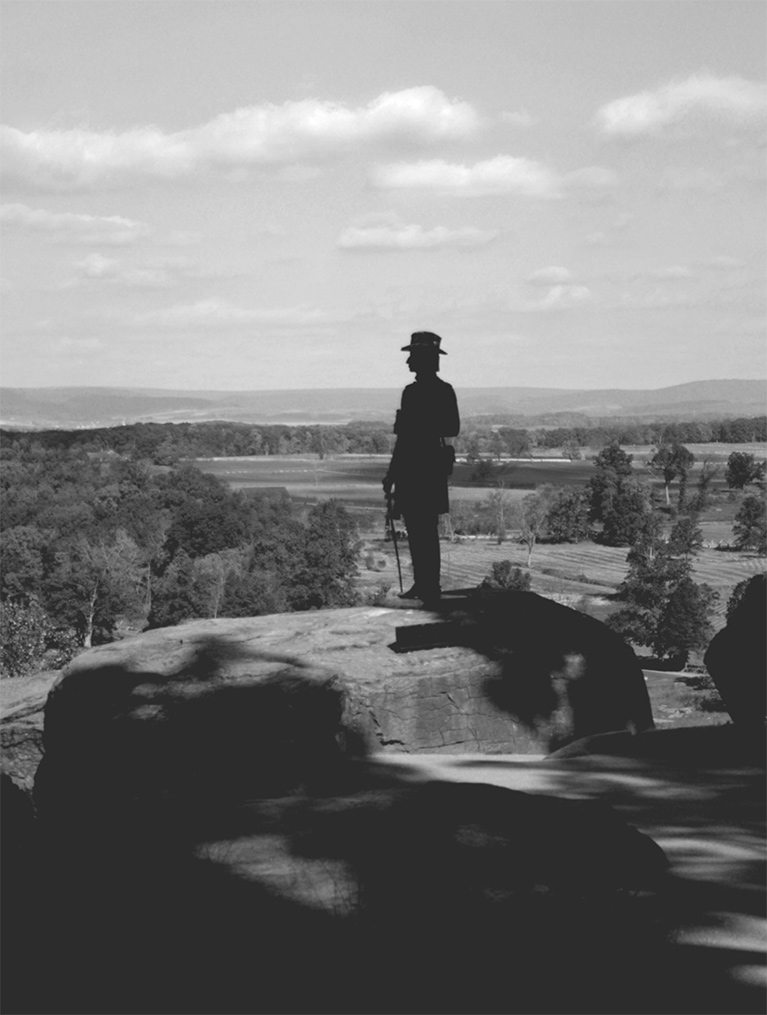
Little Round Top, Black and white photograph, 20 in. x 16 in.
You have been actively involved with NAWA for many years, both as President and Executive Director. What was the genesis of that relationship? What do you feel you accomplished for the national organization?
I was accepted into an open NAWA show in 2002 and was juried into membership in 2003. At that time, I was working for the Department of Defense and working on my Masters. At the induction ceremony I volunteered to help out Sonia Stark with the Membership Committee and became Chair of that committee in 2005. I worked with the Membership Committee all through my Presidency and Executive Director position. My motto was always “Communication and Compromise”, and those were the two themes I always stressed.
Over the years I have worked with seven Presidents, eight administrators, six bookkeepers and various part time workers and volunteers.
My Presidency lasted from 2008 to 2010, and here are a few achievements in that role:
- The NAWA Archive was expanded to include Solomon R. Guggenheim Museum, Whitney Museum of Art, the National Museum of Women in the Arts, The New York Public Library, the Library of Congress and the Film and Fine Arts Library at Harvard University.
- A grant was written and completed with the Blanchette Hooker Rockefeller Fund, and NAWA was awarded $20,000.
- A Symposium at the National Museum of Women in the Arts was held in Washington, DC, on March 28, 2009. I secured hotel reservations for all attendees. It was open to the public in their fabulous auditorium. Fifteen past presidents presented reports and discussed their presidencies and accomplishments, and Jeffrey Wechsler did a presentation about “A Parallel Presence”, an historic exhibit celebrating NAWA’s 120th Anniversary.
- The Honorary VP list was revised and a category for Honorary Lifetime Members for long-standing senior members was established.
- A summer raffle, began in 2010, was held each year thru 2020, which created an additional $4-5,000 for NAWA each September.
- The Associate Members non-juried category was initiated for emerging artists. Eventually 30 of those members applied and were juried into regular NAWA membership.
During my reign as Executive Director the following was achieved:
- I did numerous speaking engagements and participated in panel discussions to introduce NAWA as well as graduating students to the public: the New School in NYC, the Elder Hostel (formerly the Road Scholar Organization) the Chamber of Commerce, and the 100 Year Association (of which NAWA is a member), to name a few.
- I participated in a play (written by Sandra Bertrand) about the 5 founding members of NAWA, in celebration of NAWA’s 130th Anniversary. I played the part of Grace Fitz-Randolph.
- I was the POC on numerous exhibitions, for instance Point Park University in Pittsburg, PA, and the Banana Factory in Bethlehem, PA .
- I organized three trips for NAWA members and friends, with Phil Levine from One Art Travel, to Cuba and Mexico. They brought in well over $10,000 in commissions for NAWA.
- I established the Art Angels yearly “Thank You” exhibition for NAWA members who have contributed numerous hours of volunteer time to the organization.
- I founded the South Carolina Chapter of NAWA in 2018 with the help of SC artist Jennifer Rocco Stone.
- I was able to visit the Florida Chapter, the Massachusetts Chapter and South Carolina Chapter numerous times to foster a strong and vibrant working relationship.
- I initiated and finalized a traveling NAWA show “Renaissance Women” with panel discussions at six NYC Libraries, and received a grant of $12,000 from the Blanchette Hooker Rockefeller Foundation for that purpose.
- I established the NAWA Facebook page, established in March of 2011.
- A CD Library and Registry was established, wherein each artist could send in a CD or flash drive with their artist statement, resume and 20 images of their artwork. This was used for curators and special exhibitions.
- The Spring Salons were established.
- I handled the advertising, vetting jurors, and overseeing the Margo Harris Hammerschlag Award for Direct Carving from 2008 to the present.
- My husband and I organized NAWA’s move from 14th Street to 315 West 39th Street, NYC, which enabled NAWA to reduce costs, and also have a combined gallery space and office.
- I wrote a grant to the Berk Foundation, receiving a check from them for $5,000.00 that helped with to the digitization of the NAWA Archive at the Alexander Library.
- I co-founded the MA, BFA, MFA Free Graduating Student membership category in 2017. This enabled graduates to enjoy a one-year free membership.
- Each year I organized the Induction Ceremonies from the Metropolitan Museum of Art, the Helen Mills Theater to the Rubin Museum. I also organized and vetted guest speakers for our Annual Luncheon at the National Arts Club, the Harmonie Club and also the Manhattan Penthouse Restaurant. Speakers included Audrey Flack, Dr. Gail Levin, Joanne Mattera, Judy Pfaff, Faith Ringgold, Rhoda Sherbell, Linda Stein, Ursula Von Rydingsvard and Kay WalkingStick, to name a few.
Tell us something about your own vision and style of working with the photographic image.
“A moment in time” is what numerous photographers think about when they take an image. That is exactly what it is. Each moment creates a different image, due to movement, lighting and creative energy. I enjoy working with models in the landscape. The texture of the body within the landscape intrigues me. Series work is always exciting, because you can constantly find a new image to include in a previous body of work. I enjoy working in black and white and establishing a mood, and have included in my body of work nudes, landscapes, unusual scenes, portraits and flora and fauna.
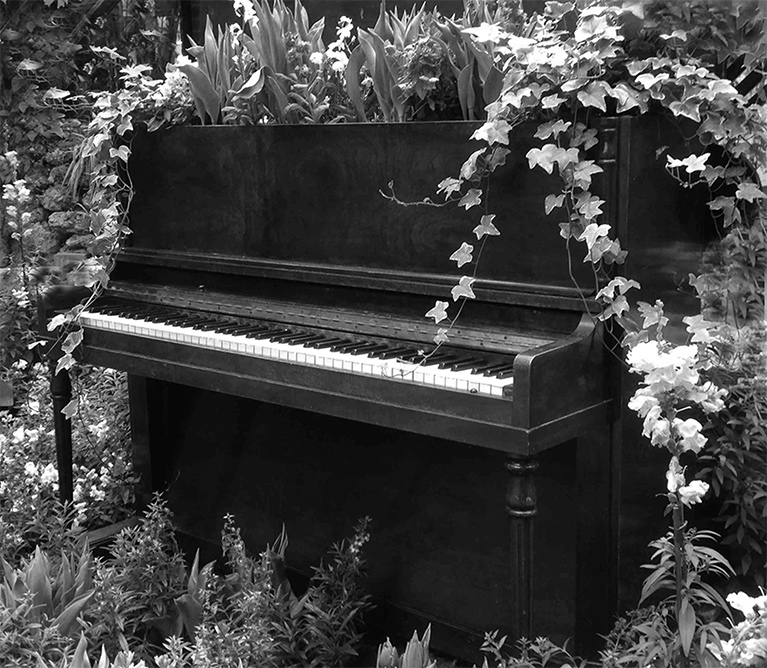
Ivory and Ivy, Black and white photograph, 18 in. x 18 in.
Have you ever felt any limitations as a woman working in your chosen field?
Through the years I have often felt that men were admired and respected for their creative endeavors, and even paid more money than women. Women on the other hand were considered hobbyists and crafters, which I always resented. I think things have changed with stereotyping in recent years. I have NEVER felt any limitations as a woman working with photography. There were occasions when taking workshops during my early career, when I was the only woman photographer, but I always tried to fit in with my sense of humor and made the best of it. While working with nudes I noticed that I always took emotional and sensitive images in order to portray feelings, moods or even metaphors, while men seemed to only take more sensual images, but that is the only difference that I ever felt in my career working with men.
Has the current pandemic had any effect on your approach to photography? How has it limited, if at all, your approach?
This pandemic has created havoc on the world, and it is so sad. Being inside so much I have taken the time to scan in over 4,000 slides and am still working on scanning negatives but have not been as productive with taking photographs. Because of the total lockdown I was not able to hire models (which I do during the summer months), nor have I been visiting places where I usually find interesting images. I have taken a few snow scenes and a few landscapes, but my enthusiasm has been a bit depleted just waiting for things to get better. I am anxiously awaiting the day when things get back to some sort of normalcy.
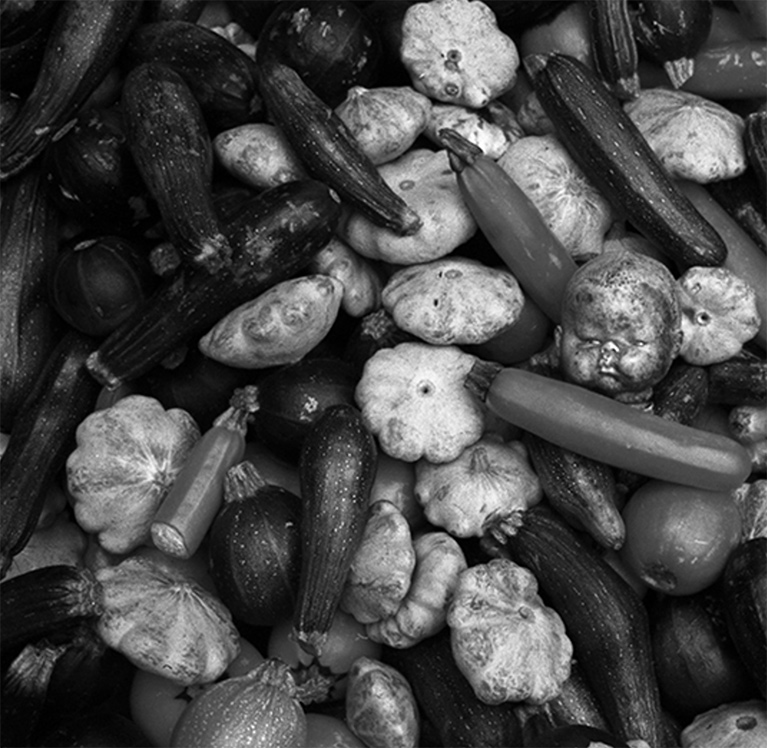
Mixed Vegetables, Black and white photograph, 16 in. x 20 in.
Since you’ve retired from your role as Executive Director, what do you see yourself doing creatively or otherwise in the near future?
I have devoted so much of my time and love for NAWA and the many NAWA members, and women artists in general, that it was quite unsettling for me when I first retired. For the first time in many years I had quiet time, plus I did not have to get up at 4 am and leave the house at 5:15 am to travel into the city a few days a week. Retirement was definitely NOT for me. I like chaos, I like 10 balls in the air (all at the same time) and trying to catch them at once! I like being busy, I enjoy being with people, having fun, working, visiting museums, attending receptions, and working on my photography. Then the pandemic hit, so again everything came to a halt for me. Twice in three months. Yikes. I am blessed with a wonderful husband, a roof over my head and food, but I look forward to the day when I can get back to doing some of the things that I love and enjoy.
What do you see for NAWA?
I look forward to the day when I can visit NAWA in its new home – the National Arts Club. I hope it will be a rewarding and exciting experience for NAWA, an historic women’s art organization and its connection with a historic landmark building.
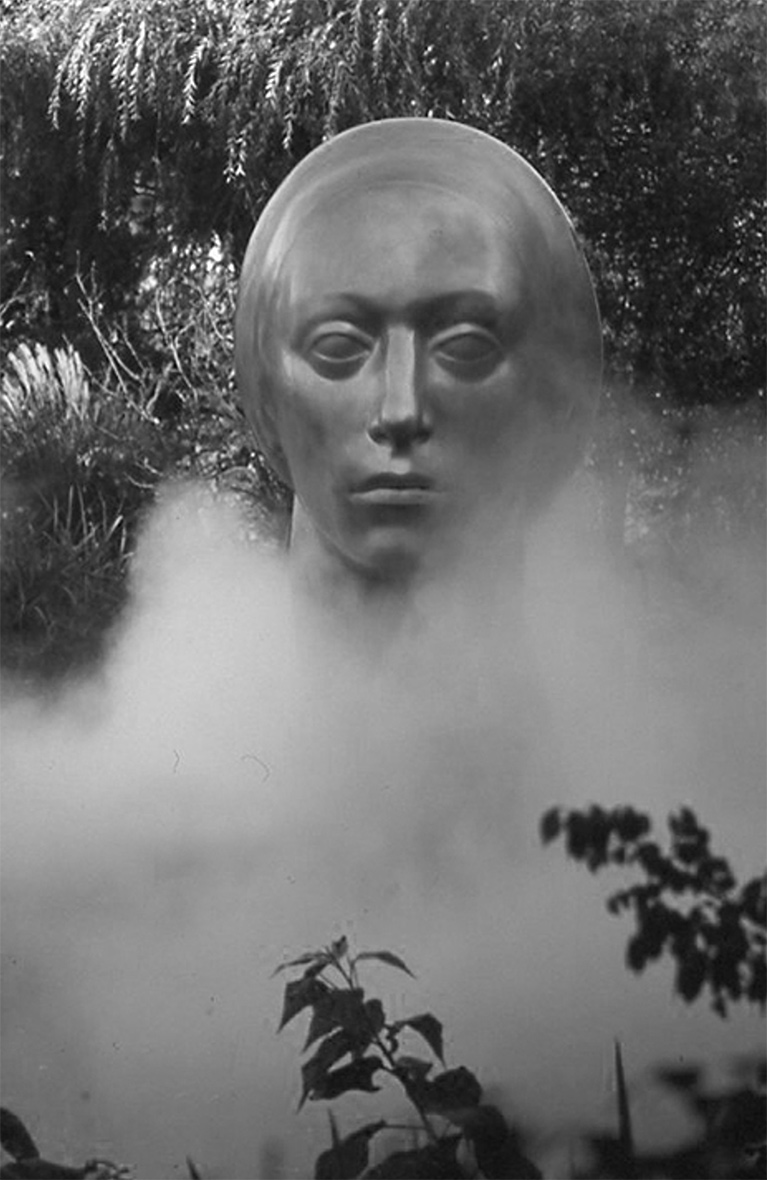
Leucantha in Smoke, Black and white photograph, 20 in. x 16 in.
NAWA SHOUT OUTS
PATRICIA CHIACO APUZZO
I work with color and the interplay between shapes, light and shadow. Color is the driving force behind my work. Although I think of myself as an abstract painter, I find working figuratively helps to balance and enhance my abstract work. I also become excited by different things and going in different directions and do not limit myself to one type of work. Using and experimenting with a variety of mediums, materials and size has also become an integral part of my creative process. I have been exploring color relationships for my entire career, and I pride myself on the fact that my art is self-contained and refers to nothing outside of itself; it needs no explanation to be fully understood. The goal of my art is to elicit an emotional response from a viewer.
Inspired by the beautifully rendered primitive shapes and figures in cave paintings and ancient African and Aztec art, Blue Innuendo and Centaur Whimsy are part of a series of paintings in which I explored those elements.
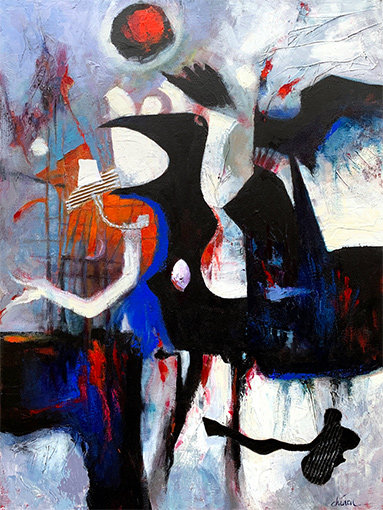
Blue Innuendo, acrylic, marble dust, cardboard on canvas, 30 in. x 40 in.
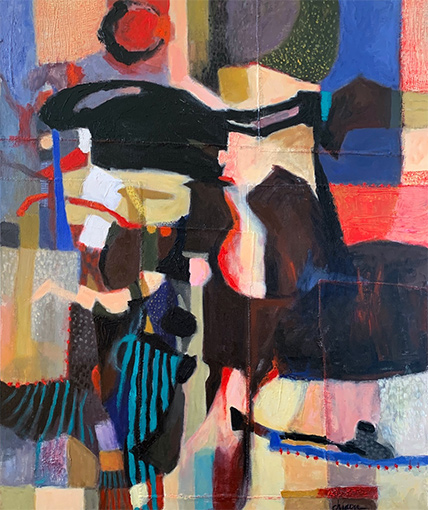
Centaur Whimsy, acrylic and oil stick on pieced canvas, 28 in. x 34 in.
NANCY JACY
The Story Behind Getting Closer
“Getting Closer” (29″ x 23″) is a portrait of my son taken at the Butterflies Live Exhibition at Lewis Ginter Botanical Gardens in Richmond, VA. This photograph was selected as the winner of the Butterflies Live Exhibit in 2019 and won our family a year long membership to the Gardens. I took many photographs that day, and I thought that the moment in time that I captured in this photograph, along with the expression of curiosity on David’s face aimed at the resting Tree Nymph Butterfly, would make a great colored pencil piece. This was completed using Prismacolor Premier Pencils, on cold-pressed Strathmore illustration board (500 series), using my own reference photographs and no solvents. I initially sketched out a simple line drawing of the image using graphite pencil on the board as my starting point and used many layers of colored pencil to achieve the final outcome. My goal was to create a vibrant, saturated, painterly feel to the piece. It was completed over a five-month period of time. It was recently juried into the Colored Pencil Society of America’s 28th International Exhibition, by juror, Chris Valle.
Nancy Jacey is a native of Richmond, Virginia, and has had a love for drawing and illustration from a young age. She received a BFA in Studio Art from Virginia Polytechnic Institute and State University, (more commonly known as Virginia Tech,) in 2002, and earned her MFA in Illustration from the Savannah College of Art and Design in 2004. She is a recognized member of the Colored Pencil Society of America and the International Guild of Realism. Nancy is an award-winning published artist. Her work has been featured in American Art Collector (April 2020 issue), To the Point (June & November 2020 issues) and Northern Virginia Magazine (January 2020 issue.) Other notable publications are Color Magazine, the Richmond Times Dispatch Newspaper and The Directory of Illustration. In her free time, she teaches classes at her own studio, The Jacey Gallery, in Richmond, Virginia.
In her words, “Go big. Despite what appears to be the current trend of murkiness and minimalism, I prefer minutia and meticulousness. I work in acrylic, oil and colored pencil. Details are important. That is why I prefer to create large-scale, photo realistic works that focus on oft-overlooked characteristics. With that in mind, my process is admittedly a painstaking one, especially with my preference for Prismacolor pencils. My colored pencil works often take hundreds of hours to complete. This is because, to me, each portion of a composition—no matter how small or seemingly insignificant—is just as important as any other part.”
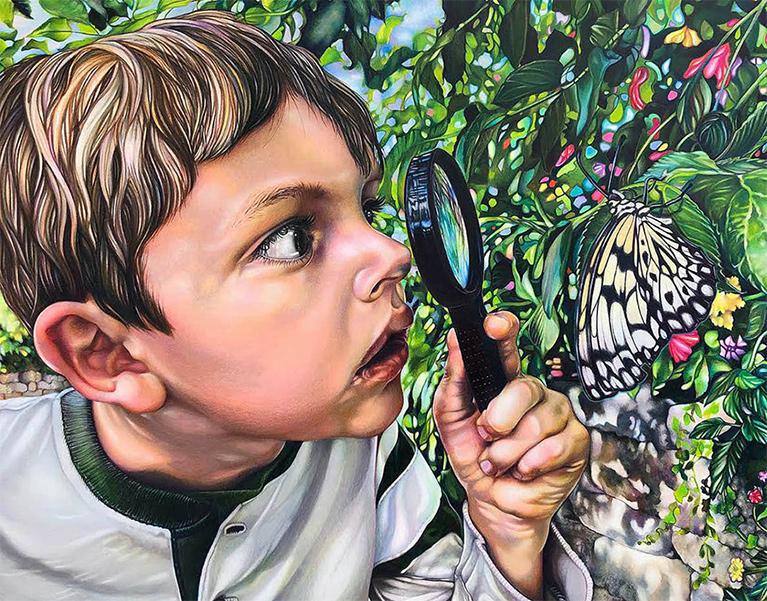
Getting Closer, 29 in. x 23 in. colored pencil on illustration board
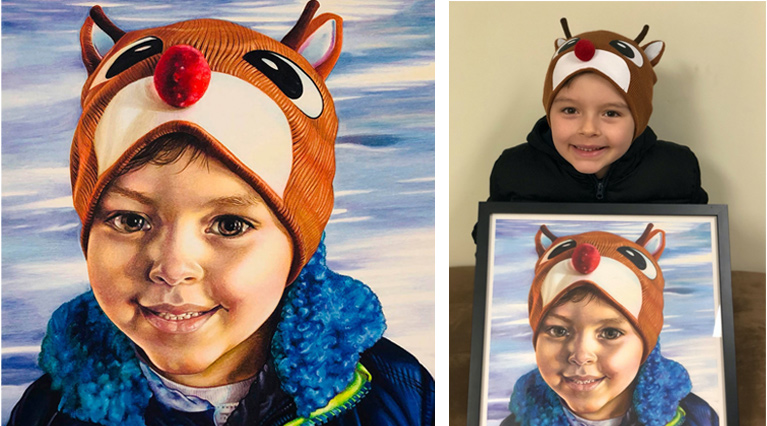
Harmony, 20 in. x 25 in. colored pencil on illustration board
C. J. Lori
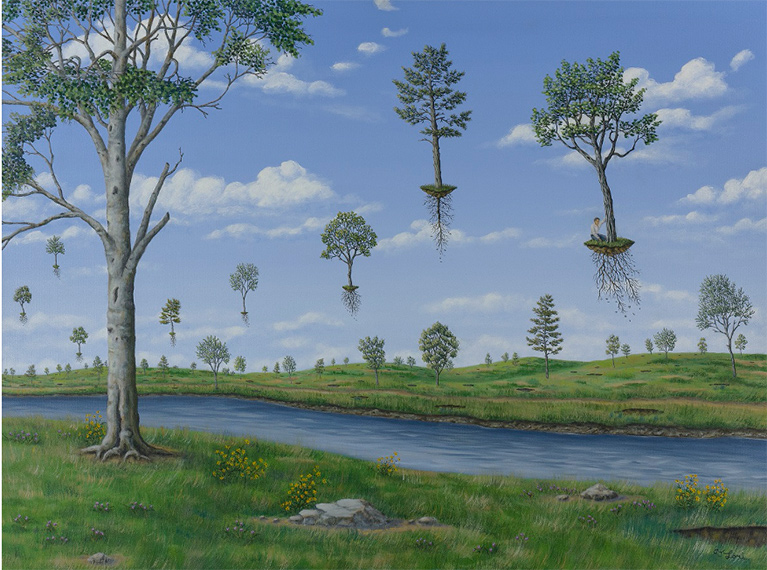
Take Me With You, Oil on canvas, 30 x 40 in, 2018
I had been painting a series of “trees leaving” since 2005, but after the 2016 U. S. election, viewers’ reactions changed. Rather than expressing feelings of loss or sorrow, they began to show a yearning to join the trees in leaving. That new reaction continues to this day. At one art reception, I heard a viewer make the comment that became the title of this painting. When I began this series I never expected to paint so many versions over the years. It has been a journey of exploration and deeply gratifying to keep this series fresh and evolving.
Lori is an oil painter living in Brookline, Massachusetts. Her work reflects her interest in literature, anthropology, and psychology, as well as an abiding fascination with the natural world. Often called “Neo-surrealism” or “magic realism,” Ms. Lori’s paintings explore the complex relationship between humanity and the environment. She exaggerates or distorts color, form, and composition to emphasize sensations that are often contradictory: clarity and mystery, excitement and sorrow, beauty and decay. In the “Trees Leaving” series, these contradictions also incorporate a touch of humor. They are part homage to Magritte’s floating men in bowler hats, part ecological statement and part allegory of loss, liberation, and the yearning for escape.
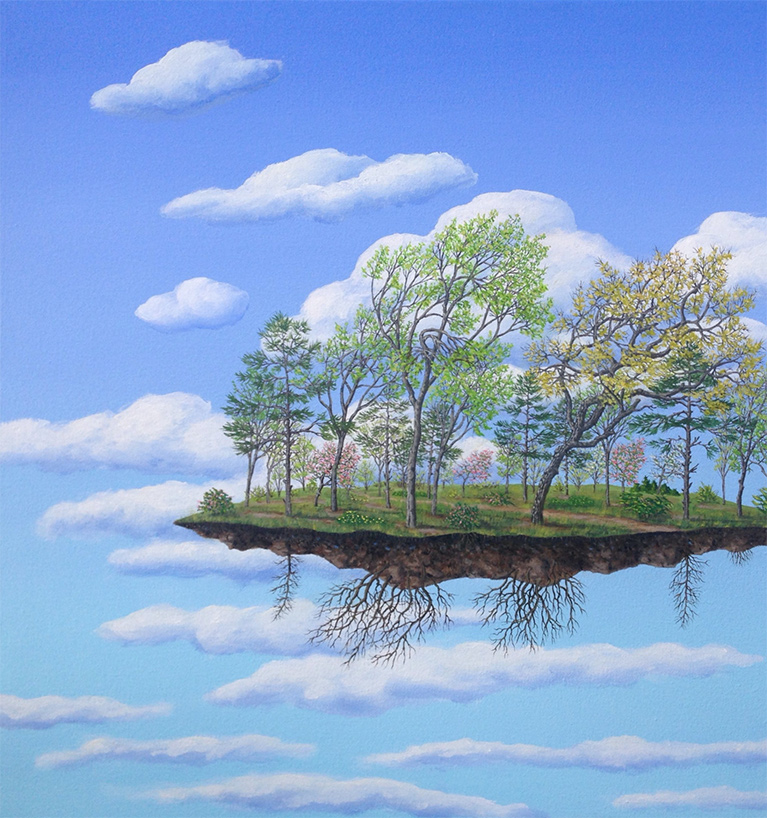
Spring is in the Air, oil on canvas 24 in. x 30 in.
Ms. Lori’s artwork has been exhibited in solo and group shows throughout New England, and in New York and Chicago. Her work has been shown at the Danforth Museum in Framingham in OFF THE WALL, Community of Artists, and Figure, Fantasy and Illusion, Selections from the Arthur S. Goldberg Collection. In 2007, she won first prize in Paint!, a national exhibition at the South Shore Arts Center.
Ms. Lori served in 1997 as First Vice-President of the National Women’s Caucus for Art, and for several years as President of the Boston Chapter. She also served as Exhibitions Chair and Vice President at Galatea Fine Art in Boston from 2017-2020. She is represented by 13 Forest Gallery in Arlington, MA and Array Contemporary in Boston.
TOOLS OF THE TRADE
LUCINDA ABRA
The word collage is from the French “coller”, to paste. Although you may have read that Pablo Picasso and Georges Braque invented collaging in 1912, this is incorrect. The fact is that in 1772, at the age of 72, Mary Delany started creating collages of botanically correct, breathtakingly beautiful flowers. Her body of work, now at the British Museum, is referred to as Flora Delanica. More can be read on Mary Delany’s amazing creativity in Molly Peacock’s book, The Paper Garden.
Scissors, a sharp Exacto blade, and a steady hand cut various elements from the many books, slowly assembling a strong narrative. I start with a concept, a feeling, or a thought and build on it. In choosing cut pieces of paper, images begin to appear. In particular, I find the negative spaces to be an essential element of the whole. It is there that work gets fleshed out in color, composition, and narrative.
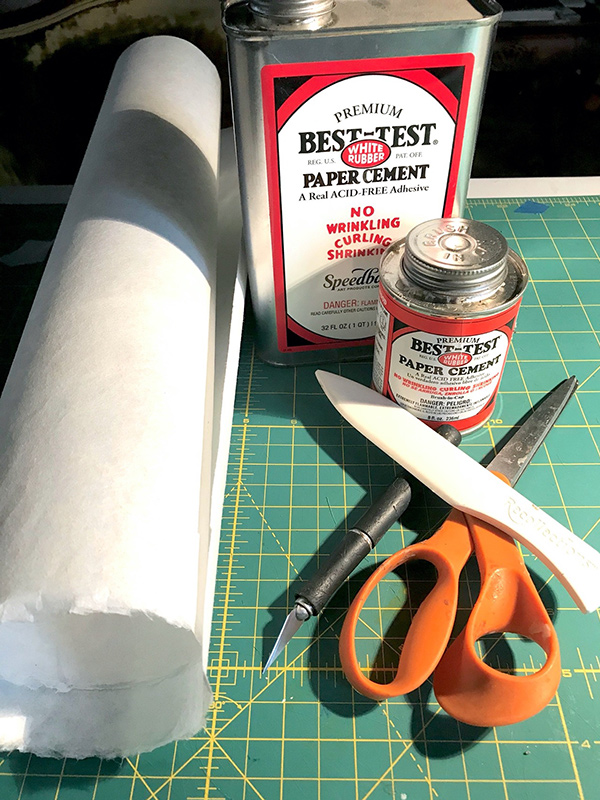
Once I have all the bits laid out to make a successful collage, I carefully glue them down, one at a time, with paper glue on mulberry paper (a very tough pH neutral paper), noting the interaction between layers. The excess adhesive is pushed out with a plastic bone folder (made initially to make perfect creases and folds in the paper for books) starting from the center. Afterward, I may use graphite or acrylic paint to make additional changes.
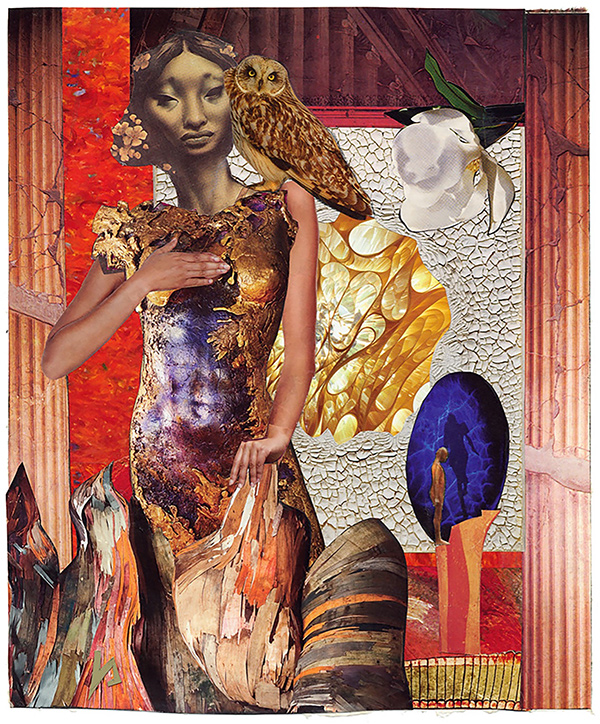
Wisdom, 27 in. X 41 in. encaustic, oil, and collage on wood.
Often using the collage as a sketch, the image is printed larger. Then, I carefully cut it, a collage born anew! Piece by piece, this is encased in encaustic on a wood surface and then painted with both oil paints and encaustic pigments, where elements can be added, subtracted, or adjusted.
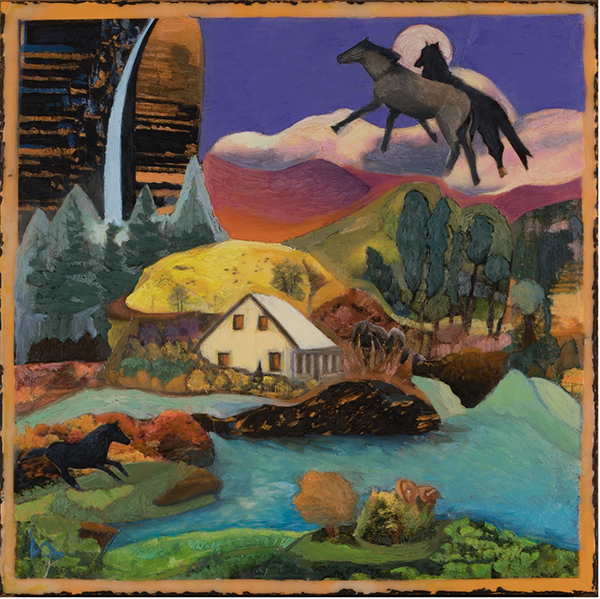
Haven, 14 in. X 14 in. encaustic, oil, and collage on wood.
I find the process quietly mesmerizing and remarkably a mirror to life itself, taking parts and portions to make a satisfying whole.
ON YOUR RADAR
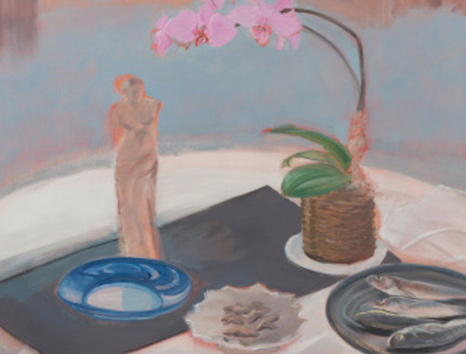
Jane Freilicher, Parts of a World, 1987, oil on linen, 68 1/2 x 53 inches, 174 x 134.6 cm. Courtesy of the Estate of Jane Freilicher.
Jane Freililcher: Parts of a World
Kasmin is delighted to announce a new exhibition of work by American painter Jane Freilicher (1924–2014) on view at 297 Tenth Avenue until February 27, 2021, comprising some 15 still lifes spanning the artist’s career from the 1950s to the early 2000s. Together, these works illuminate Freilicher’s interior world, tracing her steadfast attention to the intimate domestic subjects that characterize her scenes—flowers, drapery, and New York backdrops.
Freilicher’s light-swept canvases are instantly recognizable for their framing of everyday objects. She often situates the viewer at the threshold of the inside and outside, her scenes derived from reality but painted into a fiction. Unconcerned by traditional associations between femininity and florals, Freilicher painted instead in the same spirit and dedication as Pierre Bonnard and Henri Matisse—a subtle and unrelenting observation of domestic life. “Her pictures always have an air of just coming into being, of tentativeness that is the lifeblood of art.” John Ashbery, a close friend of Freilicher’s, articulated this phenomenon.
A Brooklyn native, Jane Freilicher came of age in the era of Abstract Expressionism at the center of a group of influential artists and poets, including painters Willem de Kooning, Rudy Burckhardt, Joan Mitchell, Larry Rivers, Fairfield Porter, Alex Katz and poets John Ashbery, Kenneth Koch, and Frank O’Hara.
Founded by Paul Kasmin (1960–2020) in SoHo in 1989, Kasmin now encompasses two gallery spaces anchored in the heart of the Chelsea Arts District at 10th Avenue and 27th Street, New York City.
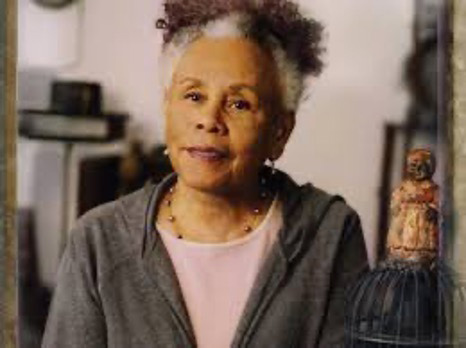
Betye Saar: Call and Response
(The Morgan Library & Museum, New York City)
(February is Black History Month, and we wanted to draw special attention to this exceptional woman artist. SB)
On August 26th, a monumental event took place on behalf of American women everywhere. The Women’s Rights Pioneer Monument was unveiled on Literary Walk in NYC’s Central Park, starring Susan B. Anthony, Elizabeth Cady Stanton and Sojourner Truth. This 14-foot bronze tribute, several years in the making by sculptor Meredith Bergmann, is long overdue. Until the present, if women wanted to see themselves memorialized in such a surrounding, they would have to go contemplate Alice in Wonderland with her Mad Hatter or the winged angel over Bethesda Fountain. Those days are gone.
Morgan Library & Museum
One of the most significant assemblage artists active today, Betye Saar (b. 1926, Los Angeles) addresses themes of spirituality, gender, and race in her work. She is part of the strong Southern Californian tradition of creating art through found objects. For the past fifty years, Saar has combined items typically discovered at flea markets and secondhand stores into conceptually and physically elaborate creations. “Finding something old that has its memory has always been important to me,” she explains.
Saar’s creative process starts with a particular found object—a piece of leather, a cot, a tray, a birdcage, an ironing board. These objects are ordinary, used, slightly debased things most people would simply pass by.
After identifying a primary object that calls to her, Saar surveys her stockpile of other found materials to see what feels appropriate to combine with it. Once she has arrived at a vision of the final work in her mind’s eye, Saar responds with a sketch: “The sketch is to remind me how [a piece] is going to look when I get it put together.”
Saar has kept sketchbooks throughout her career, laying out quick visuals for works. She has also kept more elaborate travel sketchbooks containing exquisite watercolors and collages. This exhibition offers the first public opportunity to view Saar’s sketchbooks and examine the relationship among her found objects, sketches, and finished works—illuminating, in the artist’s words, “the mysterious transformation of object into art.”
UNDER THE RADAR
VIOLA FREY
August 15, 1933 – July 26, 2004
By Sarah Katz
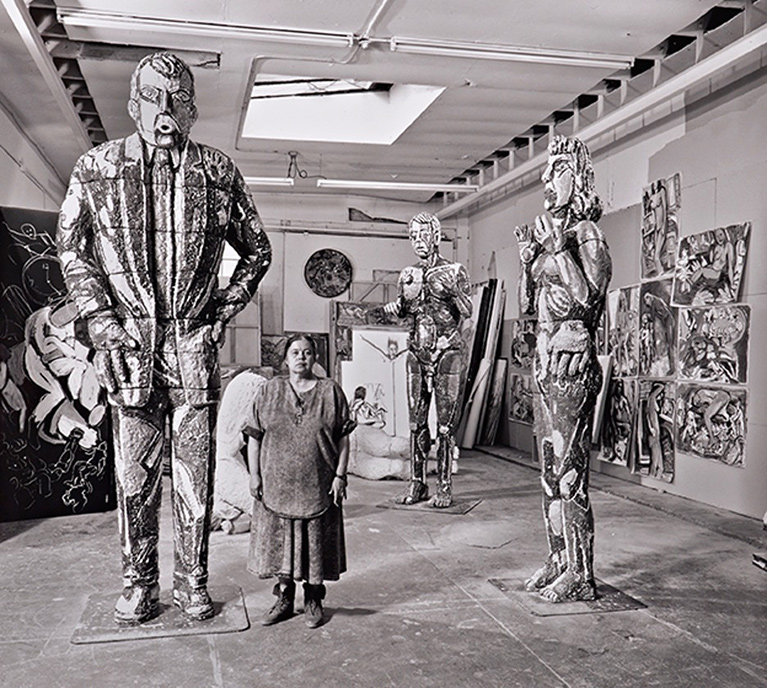
Viola Frey with monumental figures and paintings in her studio, Oakland, CA, 1987. Image courtesy of M. Lee Fatherree; artworks by Viola Frey © Artists’ Legacy Foundation/ Licensed by VAGA, New York, NY
I met Viola Frey when I went to California College of the Arts and Crafts. She blew my mind. I had had two years of study in ceramics at The School for American Craftsmen at RIT under Franz Wildenheim, a Bauhaus potter, so I had learned a very European tradition. I had begun to make pots without holes, which caused a a philosophical crisis in me and I thought if I was making sculpture, and not pots, I should change my major and study sculpture. So, I did. The forms that I was making weren’t really that much different than my pots, but then I saw Viola’s work, and everything I thought I knew flew off the table. She was making these big, round forms with objects and shapes hanging off them, fighting for space, writhing and shouting about the past, the present, and the future. It was very disturbing and wonderful and a bit scary!
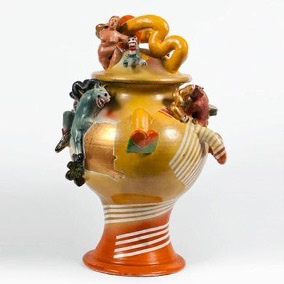
Orange Pot with Cowboy (Planetary Pot Series), c. 1970, Ceramic and glazes, 22 x 15 x 15 in.
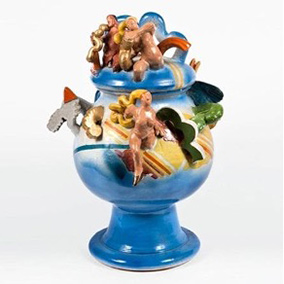
Blue Theme Pot (Planetary Pot Series) c. 1970, Ceramic and Glazes, 22 x 16 x 16 in.
From there, her work got more and more noisy: big and bold and irreverent, larger than life size figures, fired in pieces and glazed and assembled. I don’t remember what she was like as a person, but as an artist she was fearless and prolific. She seriously pushed the bounds of ceramic material. I’ve spent my career wondering about art and craft and the difference. I’ve never resolved those issues, just upped the ante on the conversation. Viola Frey left those issues in the dust.
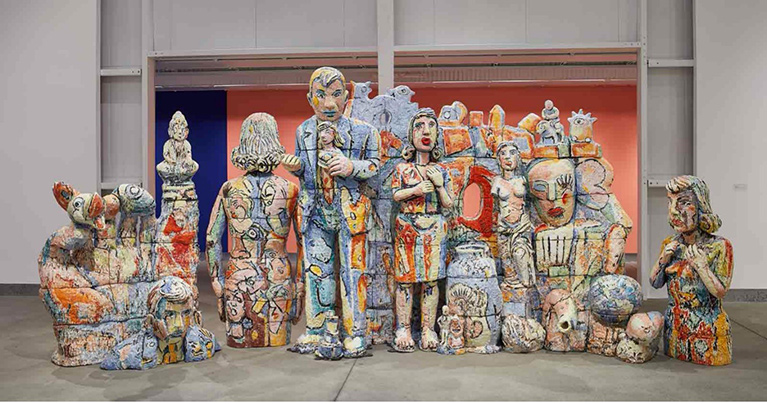
The Decline and Fall of Western Civilization, 1992 Ceramic and glazes 95 x 202 x 66 inches Artists’ Legacy Foundation, Oakland, CA 2019 © Artists’ Legacy Foundation / Licensed by ARS, New York.
She produced a large body of work over fifty years including sculpture, drawings, paintings and glass. She invented a technique for modeling directly in the clay, firing the work in pieces and assembling them into larger than life sized, freestanding sculptures. She dealt with issues of gender dynamics, asked questions about high art versus low art, and seems to have always applied her playful spirit to weighty issues.
Instead of recounting her biography, I want to share with you images of her work that excite me. I am including links to videos and articles about her.
Here is a video made for the above installation at the Flint Art Institute. It includes background information and close up images of this monumental work.
I wanted to include her in our Under the Radar section because there was a figurative sculpture show at The Met Breuer a few years ago and I couldn’t figure out why she wasn’t included. It’s true she has been shown more widely on the west coast and, she had an important show of The Fall of Civilization at the Flint Institute of the Arts, but she seems to have been relegated to “West Coast Artists” or even just “Bay Area Artists” and I think her career deserves another look.
Here is a video of an installation of her work. I think it gives you a good idea of how ambitious the work is.
Frey said of her method, “The hand of the artist was important. And that’s why the surfaces are the way they are. They’re not smooth. They’re not carved and cut down because I don’t think that the work has any resting place, you know? It’s always coming and going.”
I hope you have enjoyed these images and videos. I followed her work from the time I was a student. I also make figurative, glazed ceramic sculpture, and it isn’t much like hers, but she gave me permission to do things I wouldn’t have without her courage.
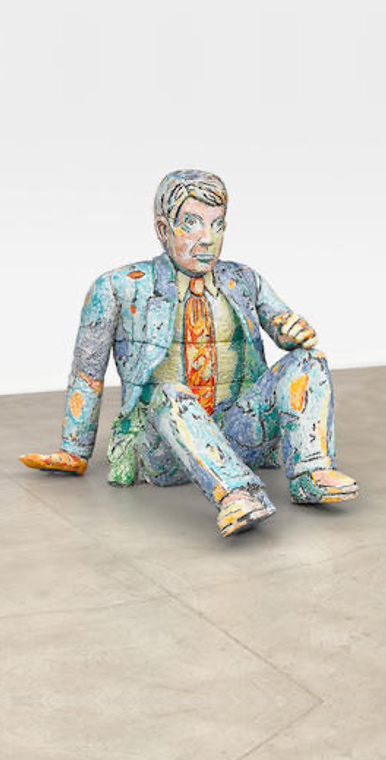
Fallen Man III, 1992 glazed ceramic (in 18 parts) glazed ceramic
80 x 72 x 90 in.
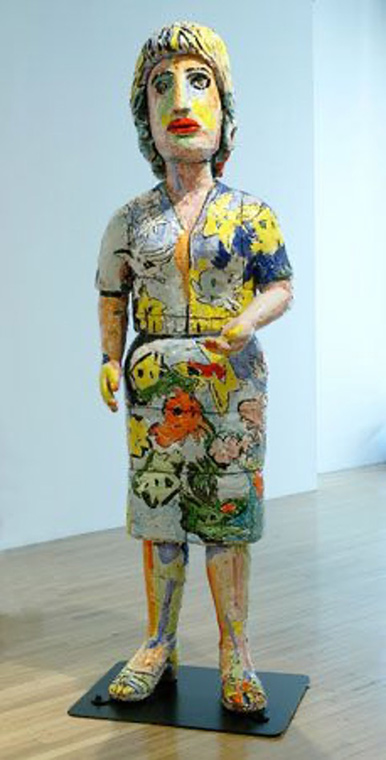
Reflective Woman II, Ceramic with glaze,
91 1/2 x 28 x 23 in. overall
WHO’S ON BOARD
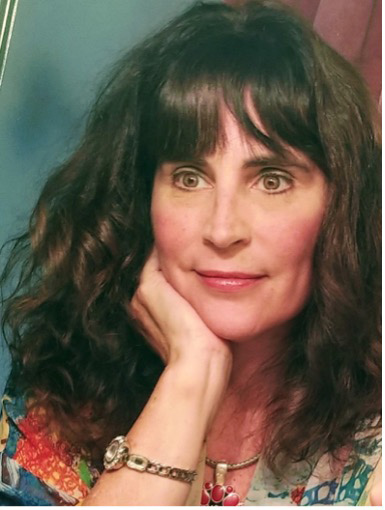
MYRNA HASKELL
(It’s a real pleasure to welcome Myrna as a new board member to NAWA. She is a talented and committed publisher, devoted to insuring women everywhere can speak their minds and hearts through Sanctuary, the women’s magazine she created. She is also one of the liveliest and warmest individuals I’ve had the pleasure of knowing and working with. She is simply effervescent, so let’s raise a glass to her success! SB)
As the founding publisher and editor of Sanctuary, a magazine devoted to creative and mindful wellbeing for women, you obviously have a passionate interest in communication, a mission of sorts to reach out to others. How did this drive that you obviously possess begin? Was it from early childhood or later?
It was after decades of writing for others as a freelance journalist and columnist that I started to think about managing my own publication. I wanted to be able to drive a publication’s voice, direction, and overall content. I had taken on many volunteer leadership roles for organizations in local public schools and communities while my children were growing up. This is when I realized I could use my leadership and organizational strengths to run something of my own.
I’m a doer – I’ve always been a person who cuts through the noise and gets things done. This has really helped me to lead Sanctuary. Of course, a lot of this also has to do with Sanctuary’s team of women – creative, professional, and giving human beings whom I trust and admire.
Did your parents encourage your creative and humanitarian interests?
My mother is a prolific reader with an incredible vocabulary and insane spelling skills. She used to edit my work early on – things like book reviews and projects in elementary school. She was also a trained dancer throughout her school years, and my love of dance and Broadway was something that she inspired. My dad is a retired IBM executive – a math guy. His business acumen rubbed off on me. He taught me fiscal responsibility – a must when you’re a business owner. My parents were also donors to charities they held close to their hearts – particularly children’s charities.
Who were your muses? Was it a particular person – teacher, friend or another source that inspired you?
I have two mentors who have become lifelong friends and confidantes.
Mary (now Mare) Leonard was my AP English teacher in high school. She encouraged me to write for the school newspaper and to continue my writing pursuits in college. We’ve stayed in touch all these years – regularly getting together for lunch and sharing our journeys. She is now on the Sanctuary Team as section editor for our Poetry Corner. As an award-winning poet and lifelong educator, she was also a featured artist in Sanctuary.
Eugene (Gene) Mirabelli was my creative writing professor when I was an undergrad. He saw something in me and has continued to offer his sage advice and encouragement throughout my career. I have followed his career, too, attending several of his book signings over the years. Most recently, I had the privilege of interviewing him in the June 2020 issue of Sanctuary.
Sanctuary often focuses on the creative process – painting, writing, and other forms of the arts. How do you express that impulse in your own life and work?
I was a fine arts minor as an undergrad. My favorite mediums were charcoal and pastel. I’ve always been interested in dance as well. For years, I was a competitive gymnast who was serious about the artistic elements of the sport. I received training in modern dance and jazz and spent several years as a choreographer for high school and NCAA gymnasts. My favorite pastimes include attending live music events, Broadway shows, and art exhibitions.
As an informed reader, what did you hope to accomplish with your own publication?
There is an inordinate amount of negativity out there, and with the continued proliferation of social media and online publications and blogs, there is also an endless amount of information; ergo, a serious consumer must navigate through the muck to get to the quality stuff.
Sanctuary was conceived as a space for women to explore and discover, to grow and reinvent. The arts and humanitarian pursuits are a big focus. But we also publish a myriad of health and wellness articles, interviews with women who have interesting career journeys, travel journals and financial advice. Also in the mix is our popular GUEST ROOM, an interactive section that enables our readers to literally be part of our community. That was a big part of the founding – creating an active community, not merely a place to find information.
How did you first become involved with NAWA and its focus and support of women in the arts?
I heard about NAWA from a couple of its members and decided to contact Susan Hammond, who was executive director of the association at that time. After speaking with Susan, I decided to feature her and the work that NAWA was doing to support women artists – after all, it was a perfect fit with our missions so well aligned. I’ve since attended several of the annual member shows, the 130th Anniversary Commemorative Reception and several other events.
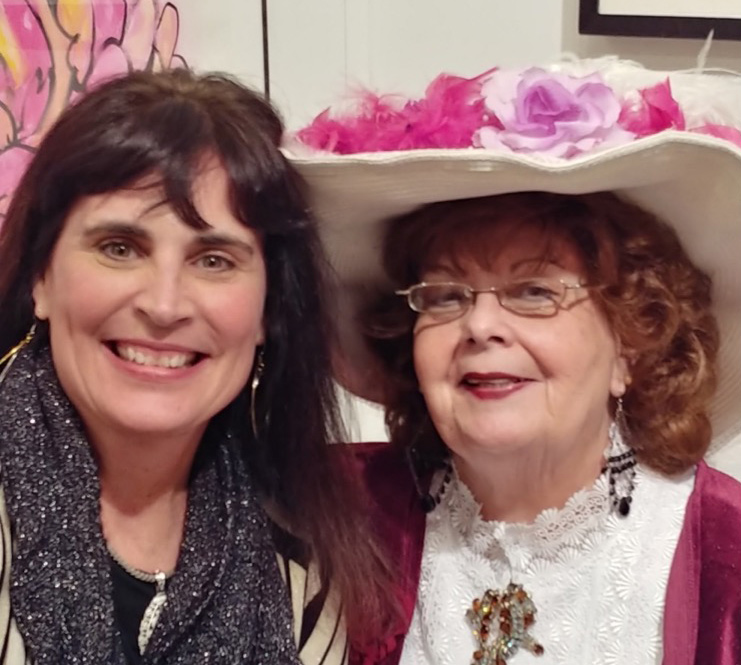
I heard about NAWA from a couple of its members and decided to contact Susan Hammond, who was executive director of the association at that time. After speaking with Susan, I decided to feature her and the work that NAWA was doing to support women artists – after all, it was a perfect fit with our missions so well aligned. I’ve since attended several of the annual member shows, the 130th Anniversary Commemorative Reception and several other events.
As a board member of NAWA, what do you think we need to continue to do to provide women artists a stronger footing in the world at large?
I am honored to begin work with NAWA. I think NAWA should continue to find ways to garner attention in the social media arena and digital space. I’ve noticed that the association is pursuing a stronger online presence with new virtual programs. It’s the future, and we’ve seen how important it can be when folks are unable to attend events and exhibitions in person. These ‘virtual arms’ that many businesses established or focused on for the first time during this pandemic are here to stay.
I think it’s also important to reach a young audience and to push for member artists who are just beginning their careers – they are the future of the organization.
Has the COVID-19 virus impacted your plans for Sanctuary and its focus? On your own life?
I think it has adversely impacted everyone in one form or another. Our focus and content remained the same, but the shutdowns, social distancing, and inability to attend events were detrimental. Sanctuary is part of several women’s business and community groups, and attendance at in-person events is essential for spreading the word about what we do. Our content is free, and our e-newsletter subscription is free. Our only means of income is through sponsorship, supporters, and events advertising. When businesses are just trying to keep people employed and are seeing their bottom line shrink to next to nothing, they are not considering new advertising expenses.
We’ve had to reimagine and get creative with new material. We started a new virtual interview show titled Sanctuary’s Coffee & Conversation, and we’ve been more active on our YouTube channel and with video creation. Fortunately, we’ve managed to keep going. We kept our chins up and forged forward. We’re hanging on and hanging in.
Personally, I’m a hugger. I miss physical contact with friends and family. I continue to worry about my parents and others who have had to stay almost completely isolated. But I’m hopeful that there are good times ahead now that the vaccine is being distributed.
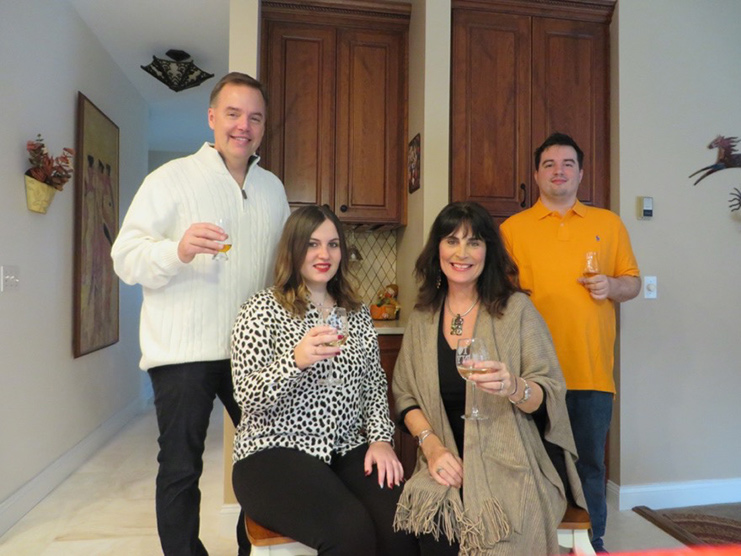
CHAPTER CHAT
MASSACHUSETTS
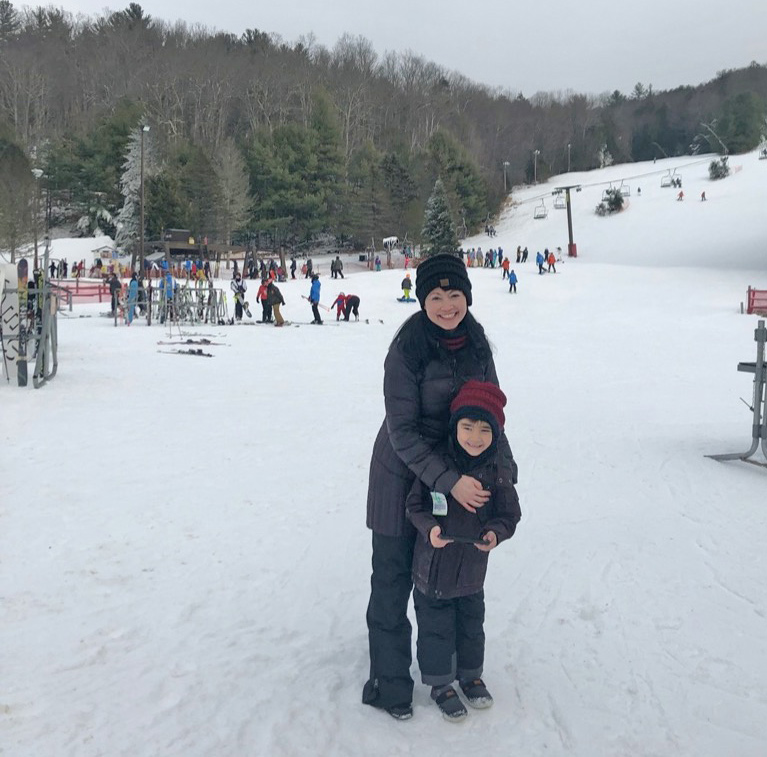
Jennifer Costello and her son in the snow.
A New Year on being even more together and stronger creatively. When we got to describing the year that had just wrapped up, my family and I were alternately joyous and maybe saddened just a bit to hear my kid’s descriptions: “A Lot Happened” seemed to be the best overall summary; “Loved Being Outside” was inspiring; and “We Missed Out” was, well, a true-to-life-bummer.
We have missed out, no doubt, and to say otherwise is being disingenuous. Yes, we haven’t been out of the state for over half a year. And because we weren’t rushing around here and there, we enjoyed more meaningful family time together this past break than, well, it seems like, ever! I truly feel like we’re beginning to see the “light at the end of the tunnel.” I can assure you, we’re not letting up on our efforts to keep everyone safe and healthy, as we continue to be a source of social connection and well-being for our colleagues.
Some of the highlights of our chapter have been continuing our members’ visibility through Hello World, An Art Affair Around the Globe (a virtual travelogue of artworks created by nearly 250 artists working in Europe, Africa, Asia, the Americas, and Australia: https://transculturalexchange.org/activities/hw/venues.htm) and our online ‘Shops’ and the power of collaboration e.g. SEBA (South End Business Alliance) to support, strengthen and unify. We continue to have sales, virtual presence, and bricks n’ mortar presence to maximize our members’ artistic talents.
Hello 2021, as we are “freshly-pressed” and smiling just like as in every other year as we continue to connect, share, and celebrate the many great things this new year can and has brought for us thus far. With that said, we are pleased to announce the ‘WOMXN’ Call for Entries. ‘WOMXN’ is an open themed juried exhibition. ‘WOMXN’ is in the mind, in the heart, and in the soul. This invitational group exhibition of 2D and 3D works explore being masculine and feminine at the same time. The willingness to endure, ‘summit’ to, or at least try. To stand up for what is right or to be able to feel the good in our hearts. This exciting exhibition opportunity is in the historic Hooper Mansion, Marblehead. MAA is in its 99th year of “bringing art to life”.
Our Chapter continues to grow with a healthy roster of 2021 and beyond exhibitions: 10 and counting, www.nawama.org/calendar , Sheltering in Place III Social, along with our Scholarship 2021 recipients to come. These bright and talented young women will each receive $1500 along with the third underwritten by Signature Consulting. We continue with scheduled demo/talks such as ‘A Few Basics of Marketing and an Introduction to Instagram’ as part of ‘Your Social Media Arsenal II&III’, along with PR coverage via sponsor Artscope Magazine, Artscope e-blast, IG, and Facebook.
Let’s end by saying ‘THANK YOU’ for being such an integral component in this shared responsibility that is being a strong creative voice.
Jennifer Jean Costello, President
MASSACHUSETTS CHAPTER
FLORIDA CHAPTER
by Roberta Milman-Ide, President
NAWAFL is busier than ever! We are currently (March 4th – April 3rd) exhibiting in the Miami Beach Botanical Garden Butterfly Gallery. Perennial Power: Women, Art & Nature will begin with our Opening Reception on the 4th and will include a Meet the Artist and a tour of the Gardens on that day, as well as a talk sometime during the month. The Gallery is open to the public Thursday-Sunday, 11am-5pm.
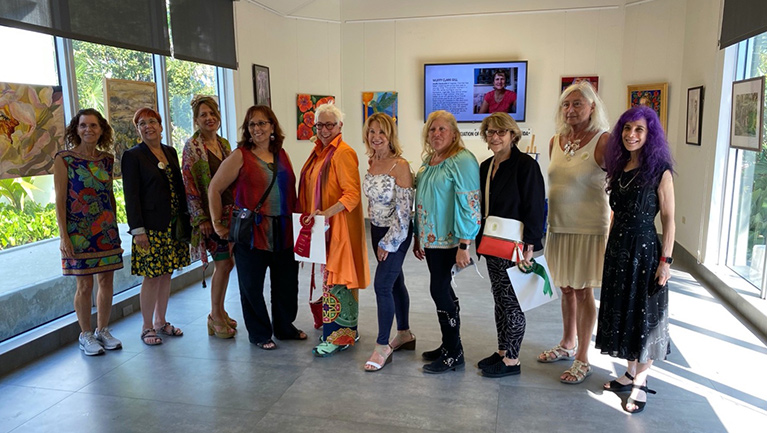
Miami Beach Botanical Garden Butterfly Gallery. Left to right: Anabel Rub Peicher, Leslie Maloff, Sara Zigdon, Roberta Millman-Ide, Judith Kirtley, Katherine Coakley, Beth Scher, Penny Seldin, Anika Savage, Judith Carlin
Our Annual Luncheon takes place at the Aura (outdoor patio cafe at Books & Books) on the famous South Beach Lincoln Road, just walking distance from our Reception. This has come together due to the hard work of our Coordinator, Katherine Coakley, and with the help of many other volunteers to make it happen.
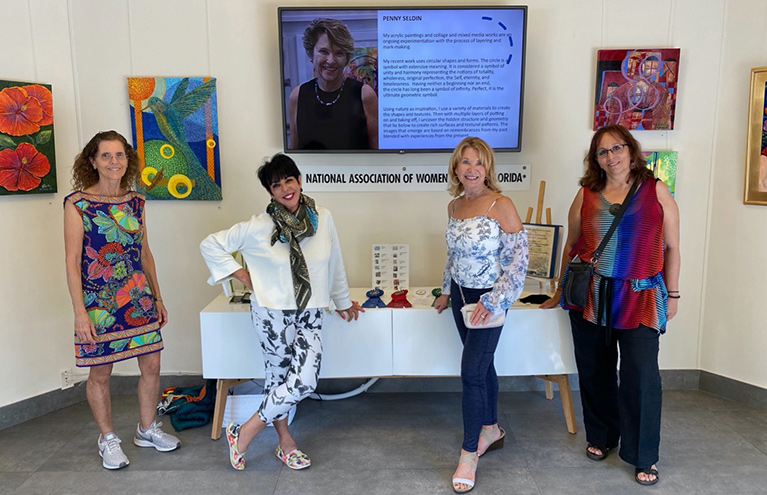
Left to right: Anabel Rub Peicher, Katherine Coakley, Roberta Millman-Ide
In June, the three NAWA Chapters are coming together again, for Some Like It Hot II; an online Exhibit. And in August, we’re looking forward to exhibiting at the 621Gallery in Tallahassee, thanks to our Exhibition Coordinator, Ann E. Kozeliski. And in between, and thanks to our online event coordinator, Anabel Rub Peicher, we’re continually engaging our members with online workshops, presentations and art salons.
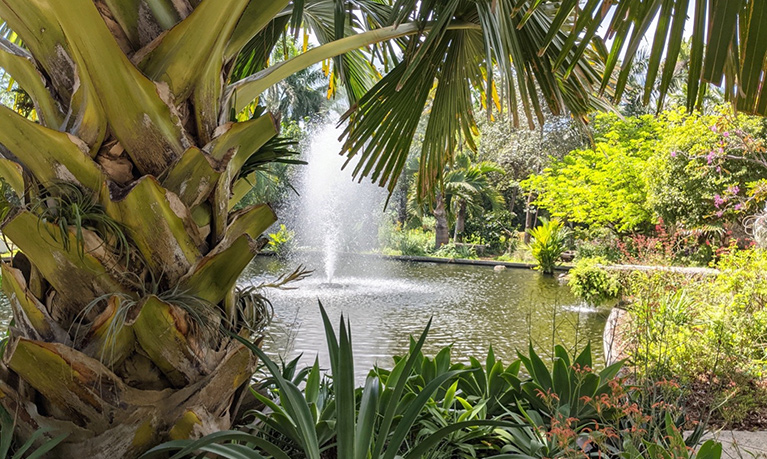
Miami Beach Botanical Garden
On February 17th, Anika Savage, Pat Zalisko & I joined up for our online artist panel on “Making an Impact with Marketing your Art & Yourself as an Artist.” And on March 23rd Pat will be hosting the 15-word exercise (a wonderfully kind way to critique others & your own artwork). And, after that, we’ll be having another Spring Salon, so all members in attendance can introduce themselves and share their current works of art!
NAWA READS
By Nancy Vineburgh
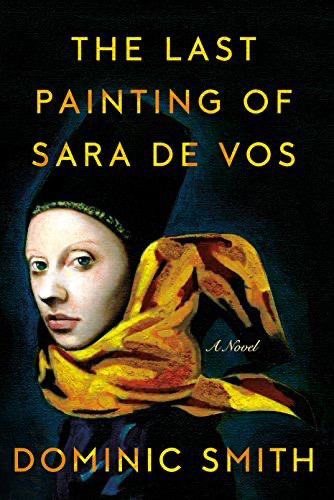
The Last Painting of Sara de Vos
By Dominic Smith
Sometimes the past enlightens us. Sometimes the past entraps us. In The Last Painting of Sara de Vos, the key protagonists are caught up in an artistic dance that enlightens and entraps them throughout their respective lives. What’s at stake is their integrity, their moral compass, their obsessions and ultimately their redemptions, each to the other.
Eleanor Shipley (aka Ellie) is an Australian grad student living in Brooklyn, New York during the 1950’s. She succumbs to creating a forgery of a painting, ‘At the Edge of a Wood’, by a Dutch, 17th century, female artist, Sara de Vos. Pigeon-holed as a still-life artist by the male-dominated Guild of St. Luke, de Vos creates the above-mentioned painting after the loss of her only child. A wealthy Dutch merchant discovers and purchases it smitten by the emotions it evokes.
“A scene so ethereal…The boy waving from the ice with the dog at his heels, his scarf nothing more than a yellow crinkle, a shaving of lemon rind. The barefoot girl with her pale hand against the birch, leaning toward the skaters…It is about the moment before nightfall, about waiting to cross over.”
Generations of the family have owned it and ultimately 300 years later, it is in the possession of family member, Marty de Groot. Stolen from his NYC penthouse and replaced with Shipley’s forgery, de Groot embarks upon a journey to find the original. The dance begins!
Shipley ends up in Sydney, Australia in 2000, a renowned art historian and curator of 17th century, Dutch female artists. As she prepares for an exhibition, Female Painters of the Dutch Golden Age, de Groot arrives from America with his reclaimed ‘At the ‘Edge of a Wood’ painting. He is seeking to redeem a past that has tormented him as the forgery has tormented Shipley. With both the forgery and the original now exposed, Shipley’s reputation and career are threatened. The resolution involves not just rescued egos, but the unveiling of other de Vos paintings that expand the scope of de Vos scholarship in the art world.
Dominic Smith, the author, acknowledges that The Last Painting of Sara de Vos surpasses his other novels in its outreach to experts. Smith collaborated with Stephen Gritt, head of conservation at the National Gallery of Canada who educated the author about lead-tin yellow. Lead-tin yellow was the main bright yellow used in the 17th century falling out of favor by 1740. Synthetic yellows emerged in the 19th century. Lead-tin yellow was difficult to make and highly poisonous, but imbued the surface with a spectacular brightness unachievable with synthetic pigments. Regarding the skater’s scarf, the original ‘At the Edge of a Wood’ possessed this illumination; the forgery did not.
I highly recommend The Last Painting of Sara de Vos for its intricate plot and adherence to many art-related topics – conservation, art history, art collectors and curatorial challenges. Add to this the human qualities around invincibility, regret, shame and redemption. These relatable emotions are further reasons for reading or rereading this literary classic.
LETTERS

Painting of Elizabeth Cady Stanton by Sandra Bertrand
When Vice President Jill Baratta recently contacted Elizabeth Blake, sponsor of the Elizabeth Stanton Blake Memorial Award (one of NAWA’s annual medal of honor awards) to verify her address, Elizabeth wrote back with some fascinating news. For our readers’ information, Elizabeth is 90 years old, is the daughter of Elizabeth Stanton Blake, who was famed suffragette Elizabeth Cady Stanton’s daughter. A distinguished lineage!
Elizabeth Cady Stanton was an artist as well as a past president of NAWA (1928-1930). In honor of such a family history, granddaughter Elizabeth has requested that NAWA’s future award reflect Cady in the award name.
We are delighted to include Elizabeth Blake’s letter to Jill, which we hope will provide you with a colorful history lesson about our organization. (SB)
Dear Jill,
I’m not a painter myself (I’m an emeritus professor of French) but stepping into the studio of any painter in oil, and smelling the turpentine and linseed oil, brings back childhood memories for me.
The Elizabeth Cady Stanton Blake Award was established by me, using income from the estate my mother passed on to me. My mother Betty Stanton was not only a professional portrait painter (E. C. Stanton) but a knowledgeable investor, having been trained by Mr. Barron (of “Barron’s Weekly”) himself. In the Great Depression, she saved the National Association of Painters & Sculptors (as NAWA was then known) by selling its old headquarters building & buying The Argent Galleries, on 57th St., near Carnegie Hall. That location became the center of art action in the 30s & 40s, allowing the Galleries to do well.
I look forward to receiving the Annual catalogue. That also brings back memories. I believe Eleanor Roosevelt came to the Opening Exhibition one year. I was thrilled when she shook my hand—I kept my glove (children wore gloves in those days) for years!
Wishing you much success in your own work,
Bettina Blake
RECENT, CURRENT AND UPCOMING MEMBER SOLO, TWO PERSON AND BIENNIAL OR INTERNATIONAL EXHIBITS
Marla Brenner and Terri Beck-Engel
Firefly Coffee House
Oregon, Wisconsin
March 2 – April 30, 2021
Kathleen Zimmerman
EXPLORING
GR Art Gallery
1086 Long Ridge Road
Stamford, CT
(Kathleen Zimmerman’s serigraph, To Be or Not To Be? Forest, was juried into the International exhibition, Printmaking from the Edge! This exhibition is hosted by the award-winning Art Center in Dover, New Hampshire, from January through February 2021, both virtually, and on location. )
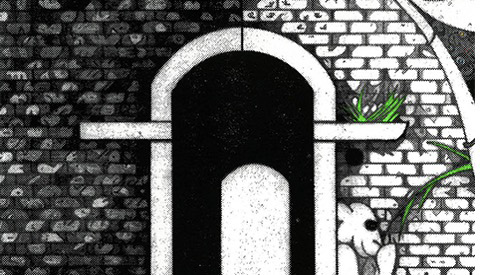
Denise Lorenz
Lone Star College CyFair Continuum: A Retrospective
5000 Research Forest Drive, Cypress, Texas
January 21 – February 25, 2021
Natalia Koren Kropf
President Natalia Koren Kropf had an impressive new international solo exhibit (November 14-December 19, 2020) we are delighted to bring to your attention, as well as her touching description that accompanies it.)
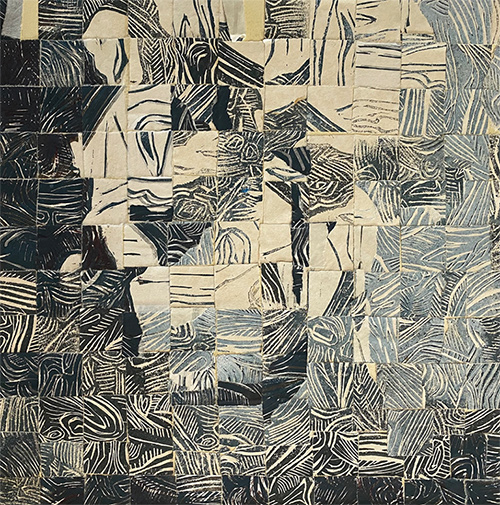
Time for Air, original, with monotype fragment, 12 x 12 in.
Paying the hommage to her native St.Petersburg, Natalia created a new series of work on paper Daily Eternal describing the relationship between the elements of Nature and Human activity in the Baltic Sea region and beyond.
Her work presented in the IV International Art Festival Living Gulf of Finland 2020 at the Modern Art Museum ARTMUZA raises the awareness of our daily living by putting it in a timeless perspective. It reminds us that even the air cannot be taken for granted. A sustainable lifestyle is not an option – it is a necessity. It is time to remember that we consist of the same elements as our surroundings.
DAILY ETERNAL series
The time in which we happen to live needs us.
We need clean air, drinkable water, habitable climate.
This year’s global events teach us how interrelated all the components of nature and society are.
Thus, disharmony in one element, namely the air, is affecting all aspects of life.
Air exists in time. The climate has its location.
Transformation is a property of water, while Consciousness is a human quality.
My recent series DAILY ETERNAL represents a visual contemplation about the relationship between the elements of Nature and interfering human activity. The collage TIME FOR AIR reflects how the daily vital need to breathe is tightly intertwined with the timeless but not limitless resources of the earth, water, fire, and air.
© Natalia Koren Kropf
December 2020, New York City
To see more of Natalia’s exhibition, please go to:
https://www.korenkropf.com/daily-eternal
PUBLICATIONS
Sandra Bertrand
Highbrow Magazine, “Philadelphia Pays Homage to Illustrator Wanda Gág”
(Some artworks are so timeless, they never go out of style. But every now and then, these creations and the creator behind them need a little push to bring them into the light again. The Philadelphia Museum of Art has done just that with its current exhibition Artist in Focus: Wanda Gág.
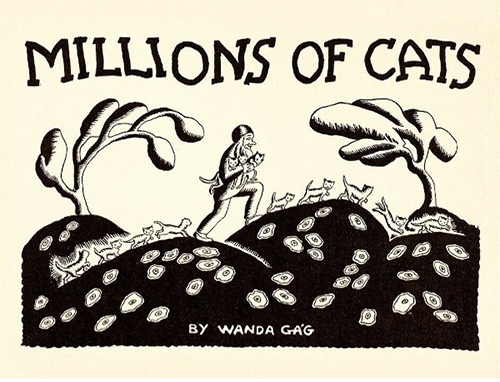
To have created Millions of Cats, the oldest American picture book for children still in print, is laudable enough, but Wanda Gág (1893-1946) proved herself time and again with her distinctive drawings, woodcuts, watercolors, and lithographs.)
Amy Hutto
Cover Art
Discover Fort Collins
Patricia Raible
Artworks for Next to Godliness, story by Rose Himber
North Carolina Literary Review 2021
A FEW WORDS FROM YOUR CO-EDITORS
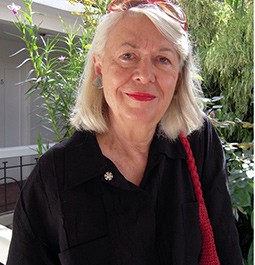
Sandra Bertrand
sbertrand0319@gmail.com
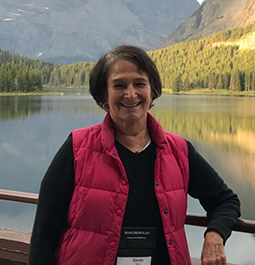
Sarah Katz
skatz181@me.com
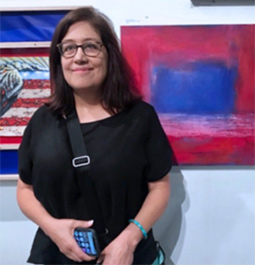
Mimi Herrera-Pease
mimi4color@gmail.com
For women have sat indoors all these millions of years, so that by this time the very walls are permeated by their creative force…which has, indeed, so overcharged the capacity of bricks and mortar that it must needs harness itself to pens and brushes and business and politics. (Virginia Woolf)
I recently discovered those prescient words on a pamphlet for NAWA’s permanent collection at the Jane Voorhees Zimmerli Art Museum at Rutgers, the State University of New Jersey. I couldn’t help thinking of how many of us have spent our daily lives indoors during the current pandemic. In addition to daily chores, some of those hours have been spent trying to harness our creative powers, to summon our better angels to create the artwork that lies within our minds and hearts.
Now, with the promise of vaccinations on the horizon, a new day is coming. Just as spring bursts forth with new life, filling the air with fresh expectations, we too will find new inspiration. NAWA has a new home at the National Arts Club, with future plans for the events and exhibits that will unite us again.
We encourage you to reach out to us with your news. This is your newsletter, and we want to fill it not only with your exhibitions but the thoughts and activities that replenish and inspire you. Please keep in touch as we continue to make NAWA the strong and supportive national organization it has proven itself to be!



